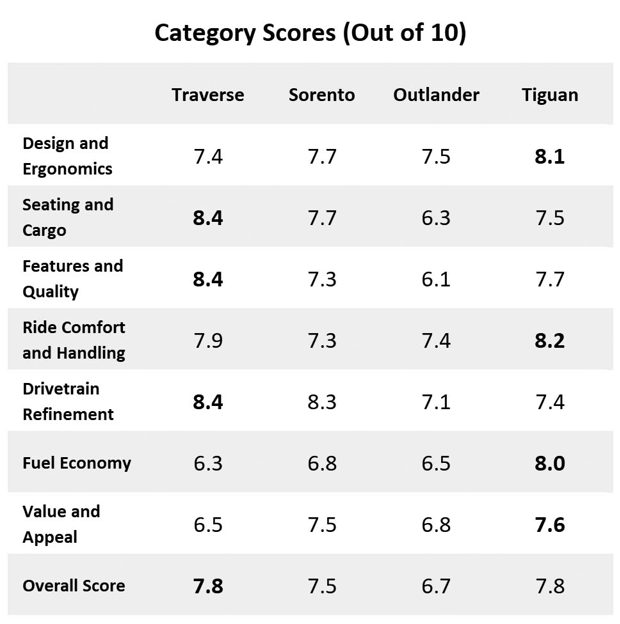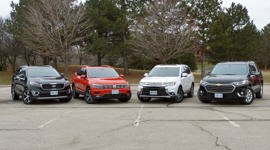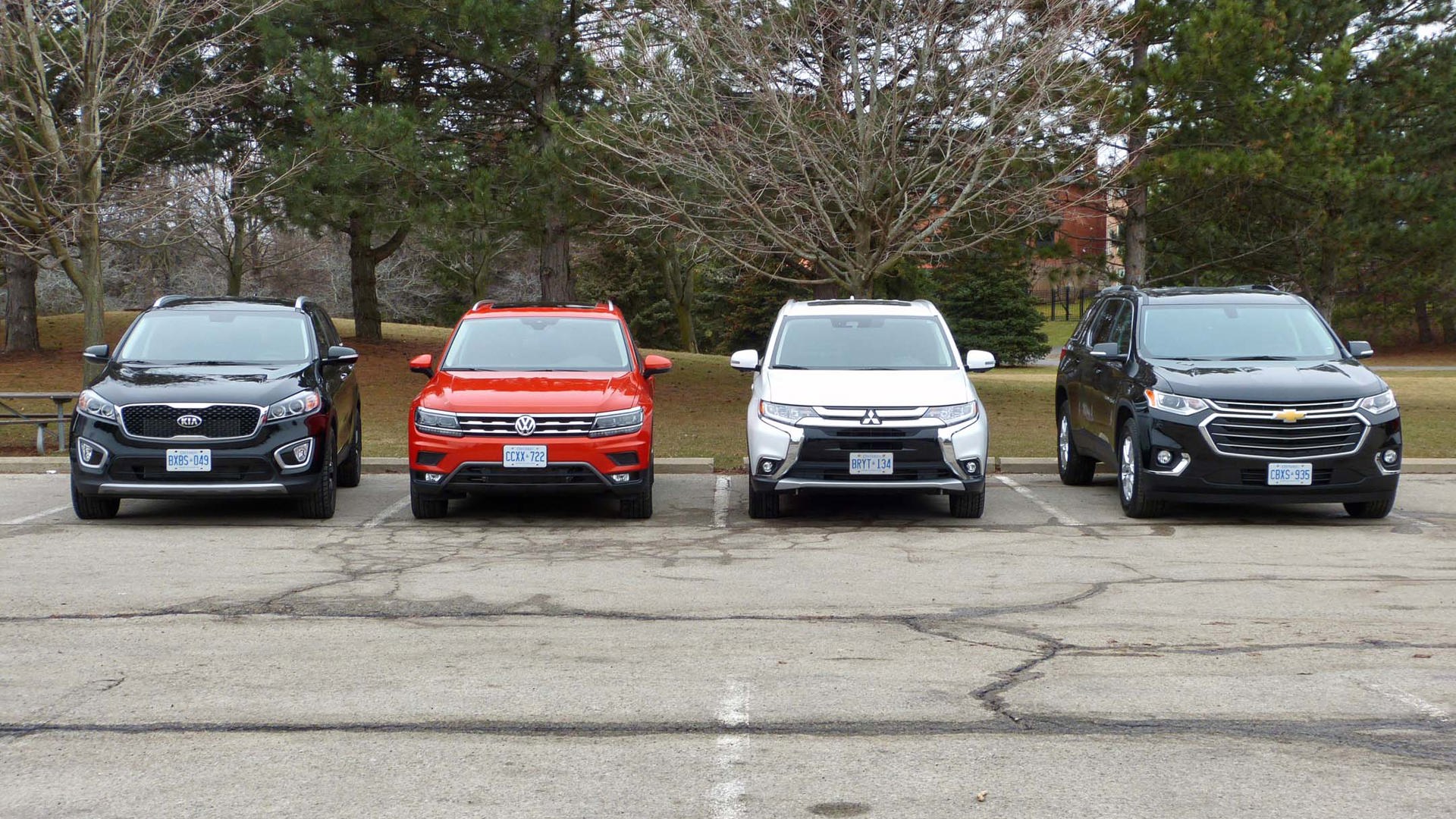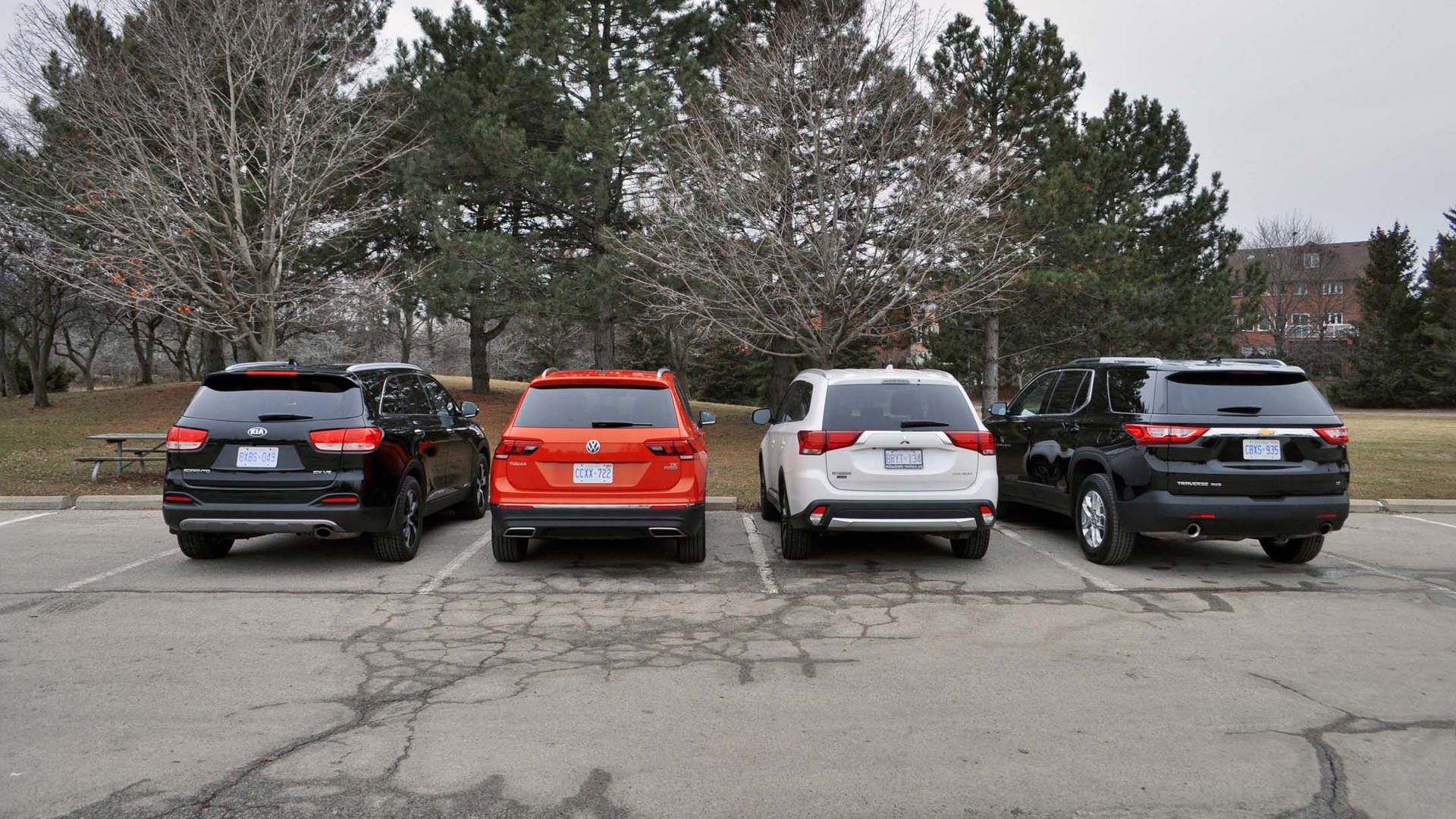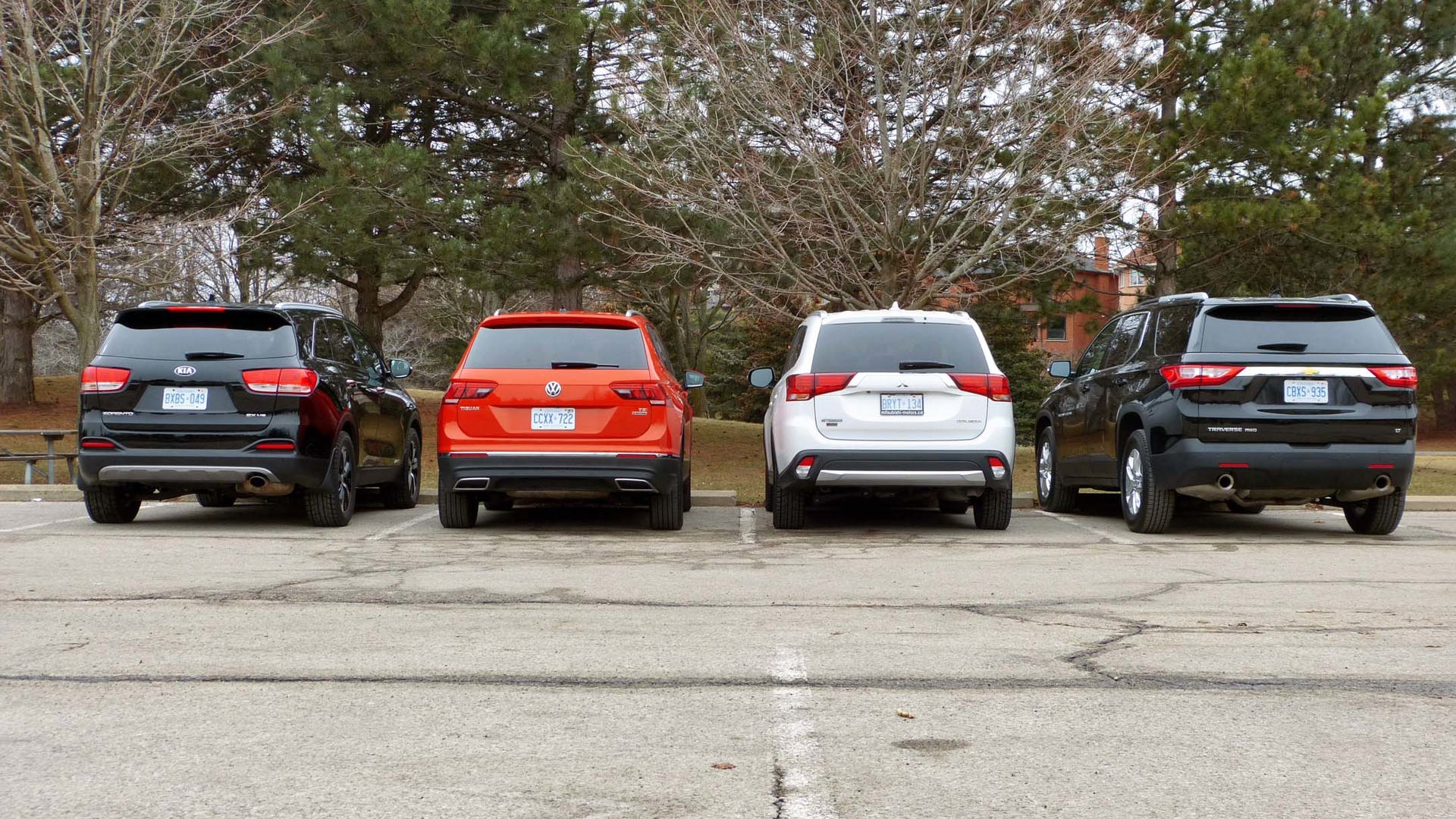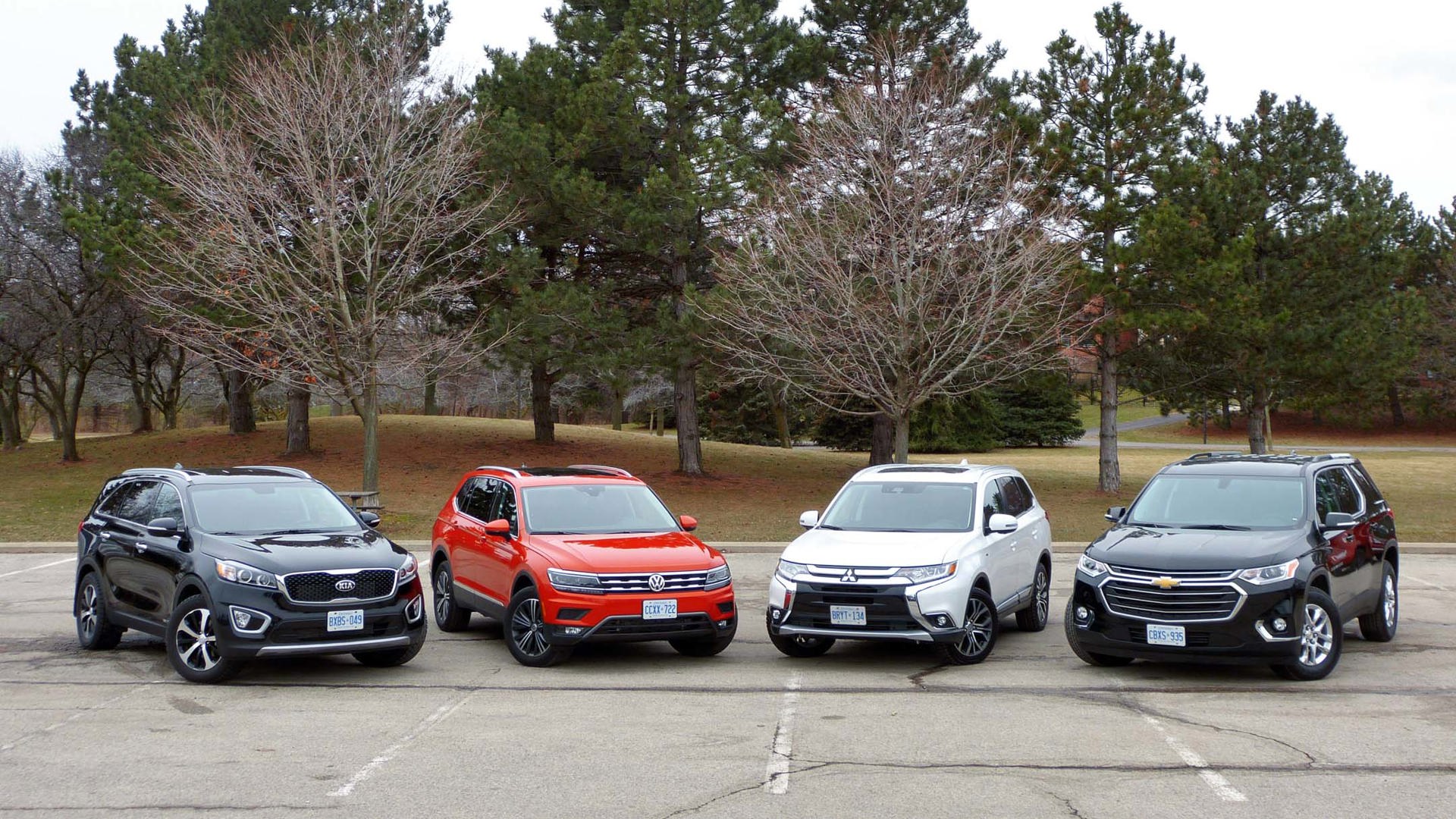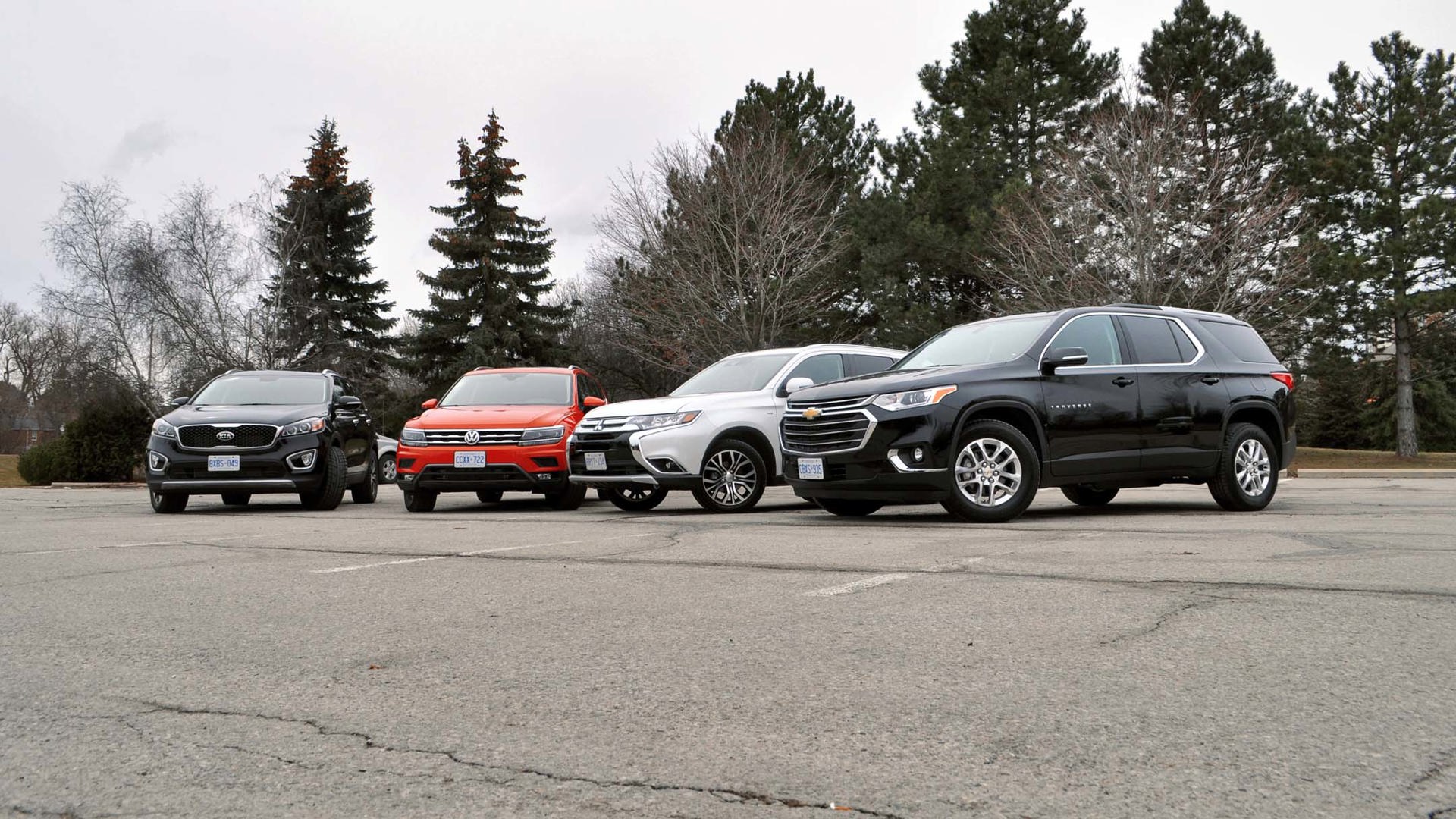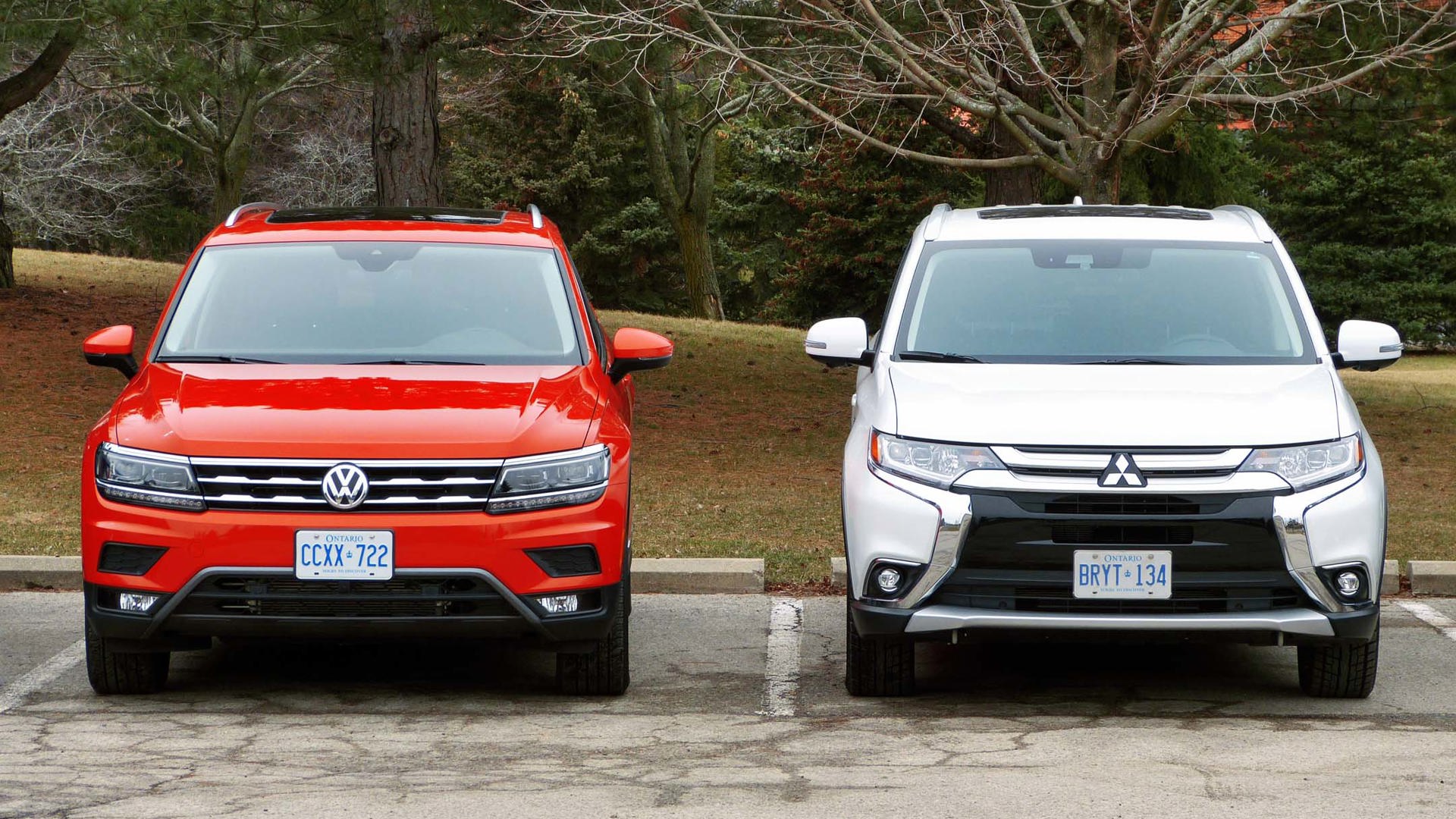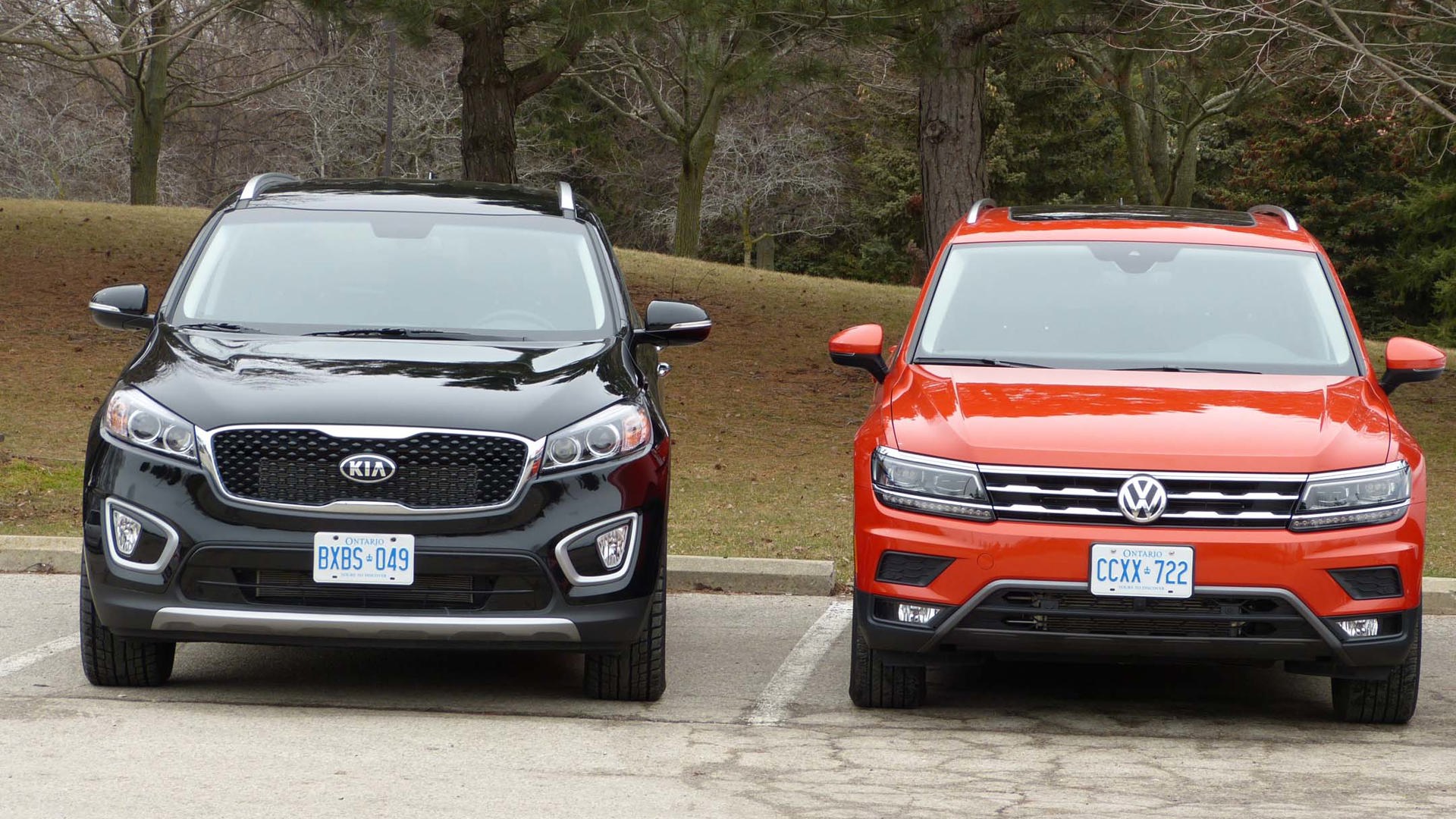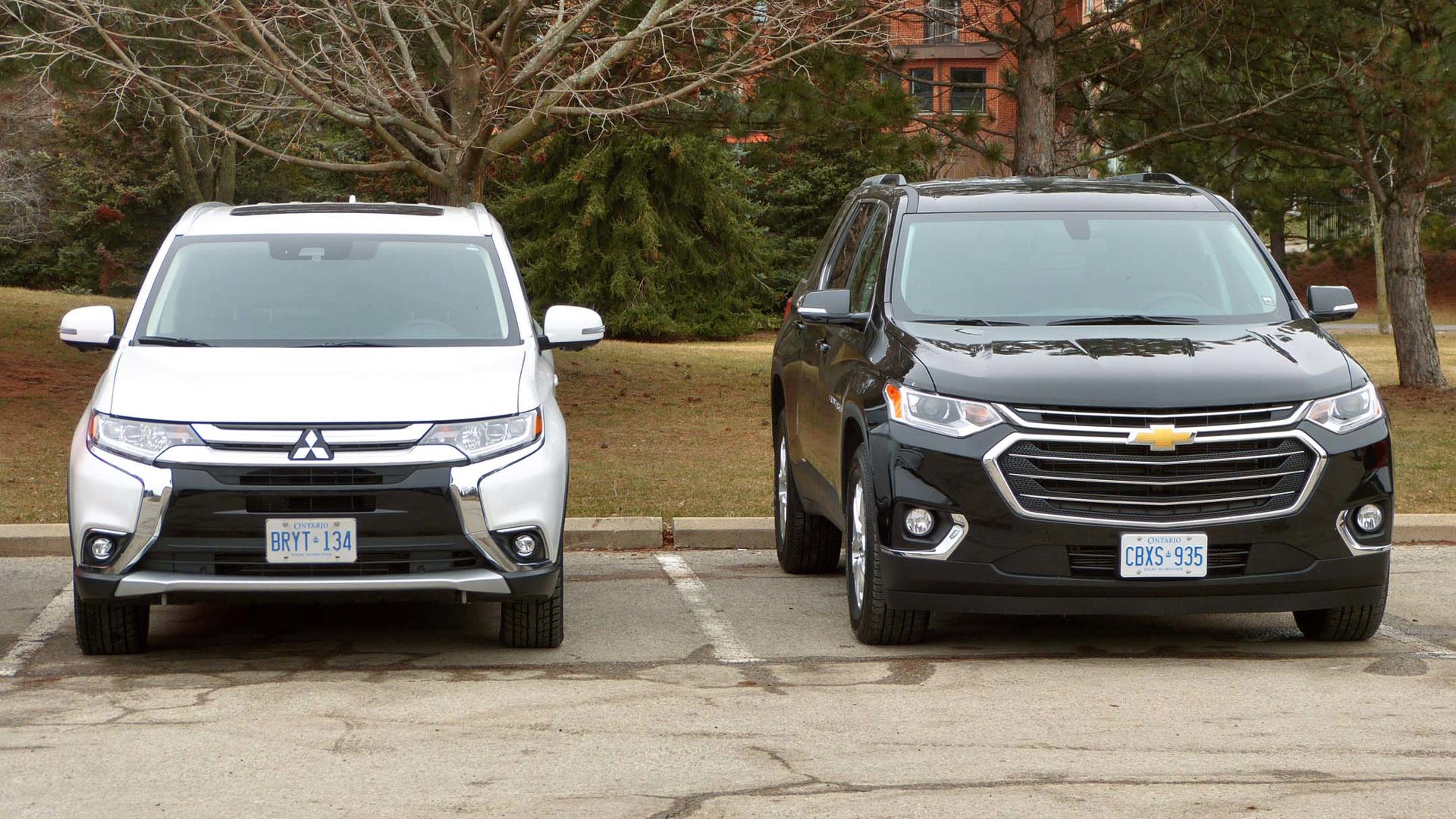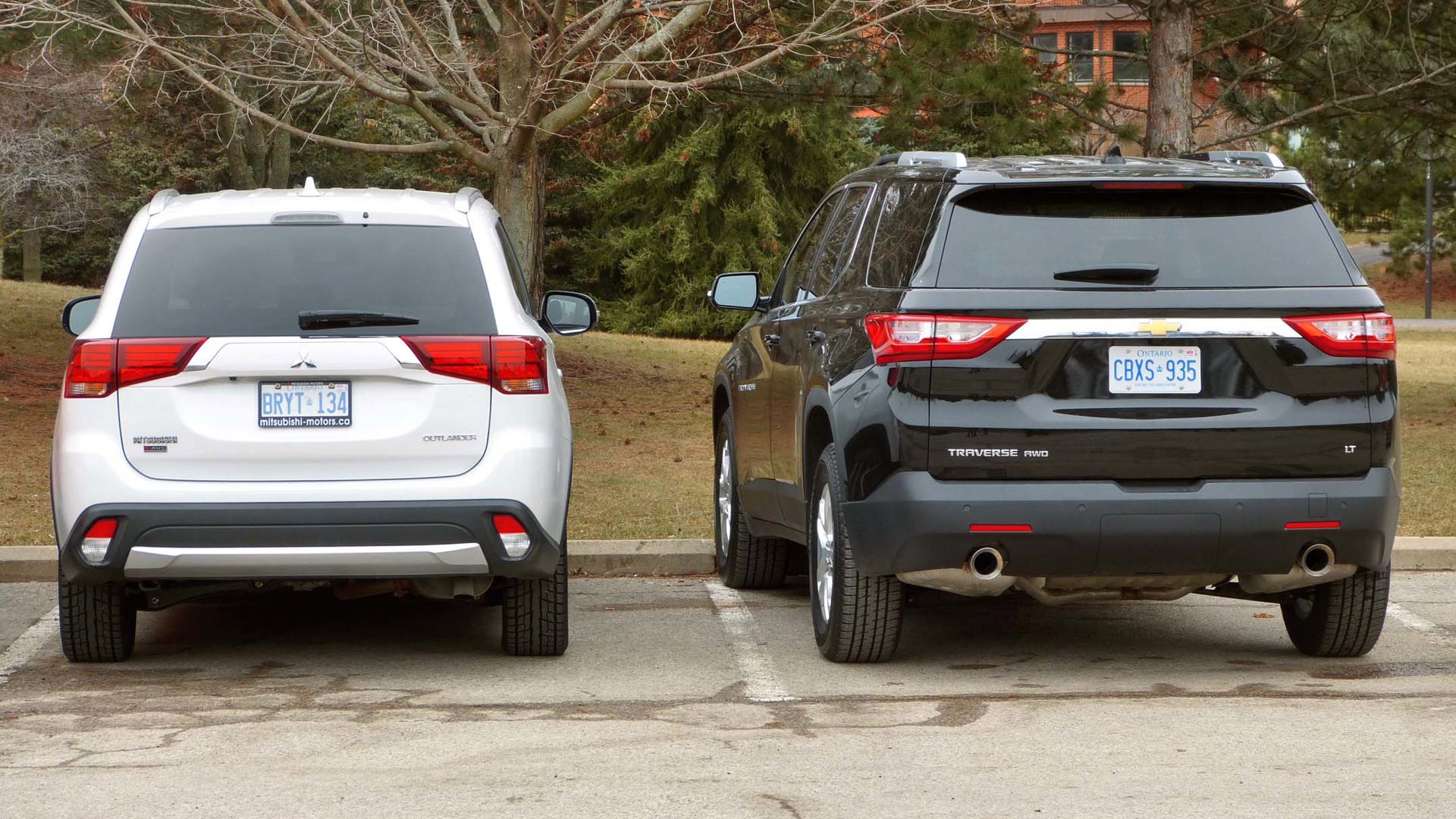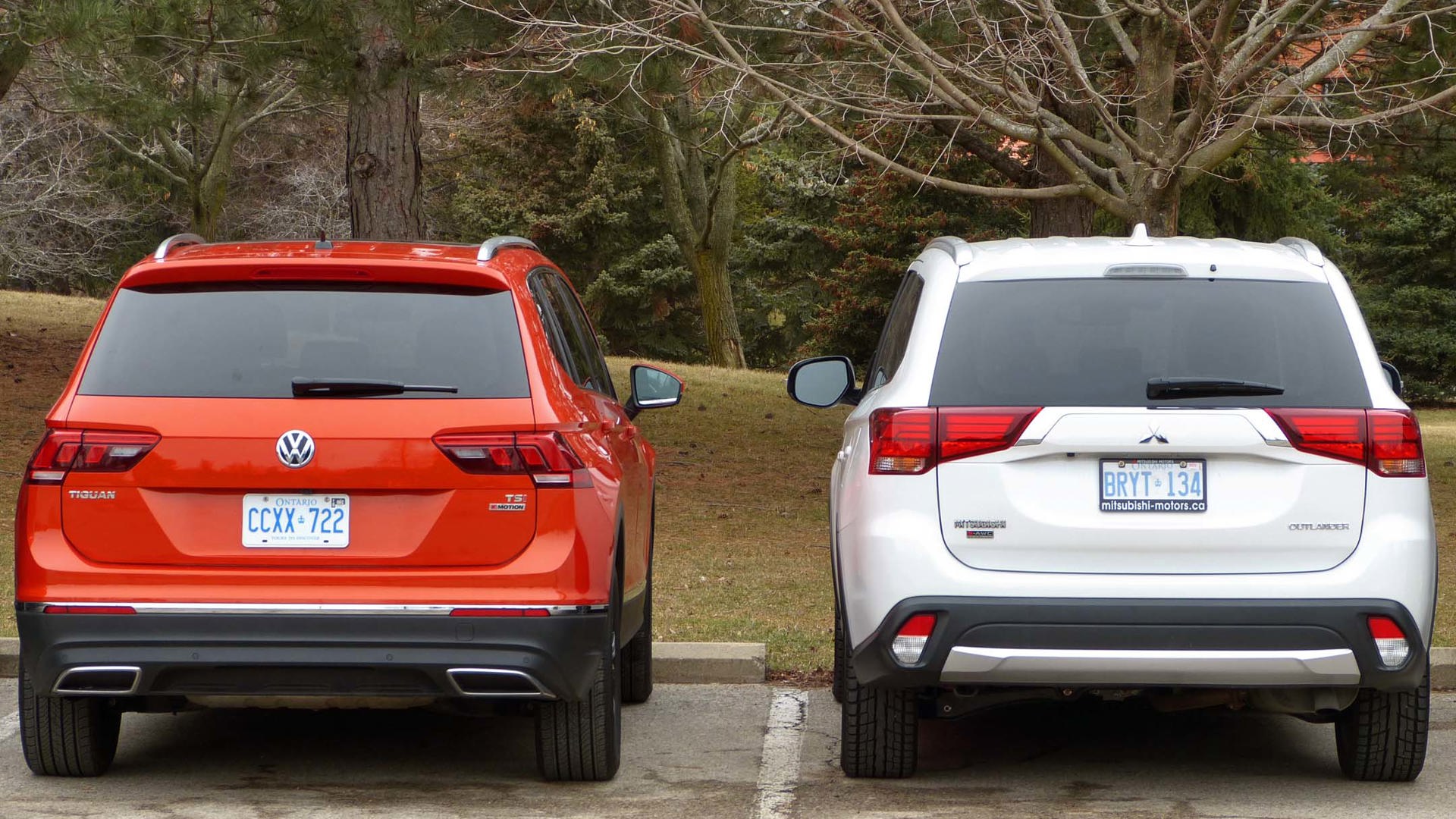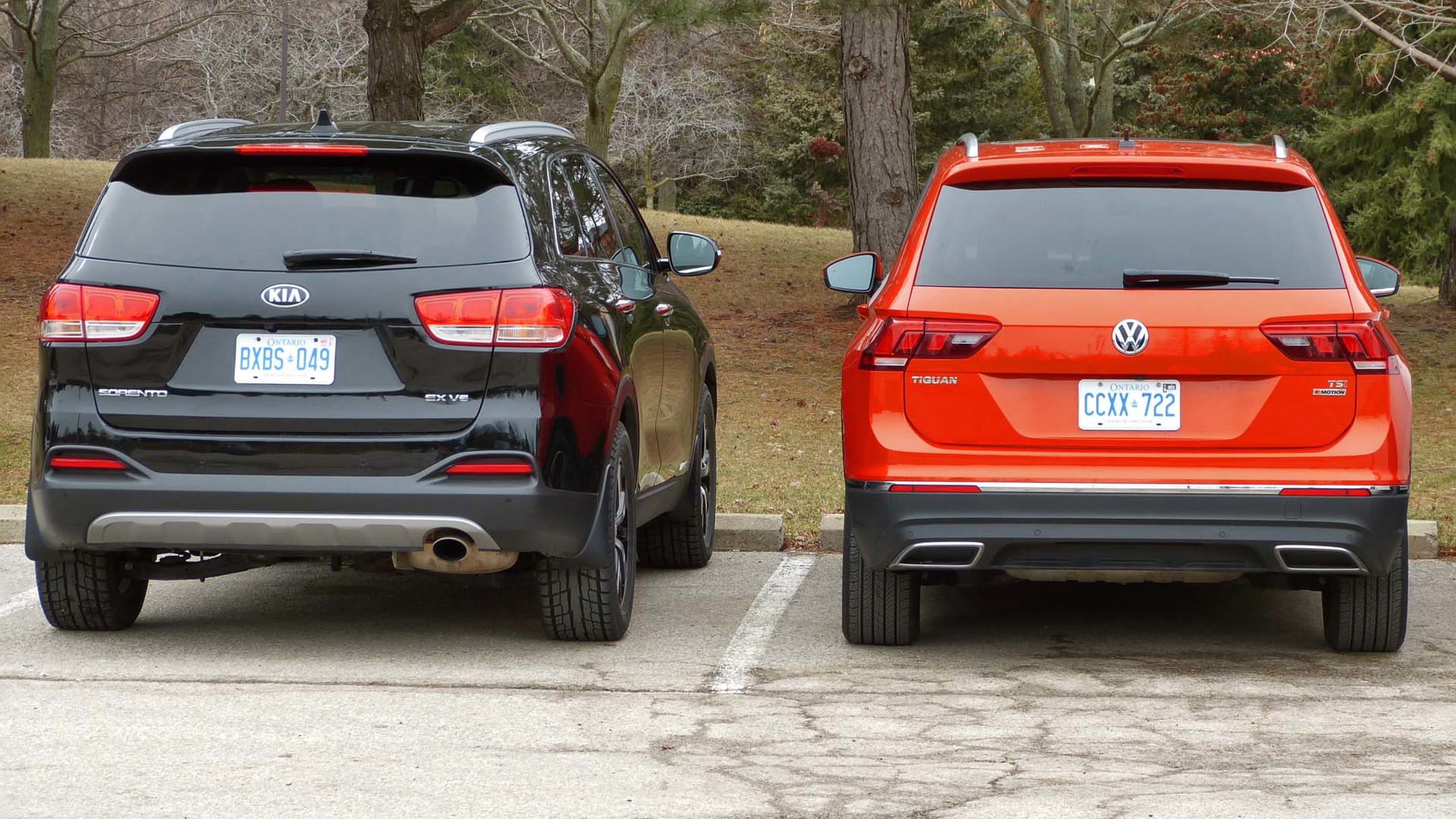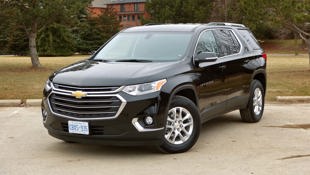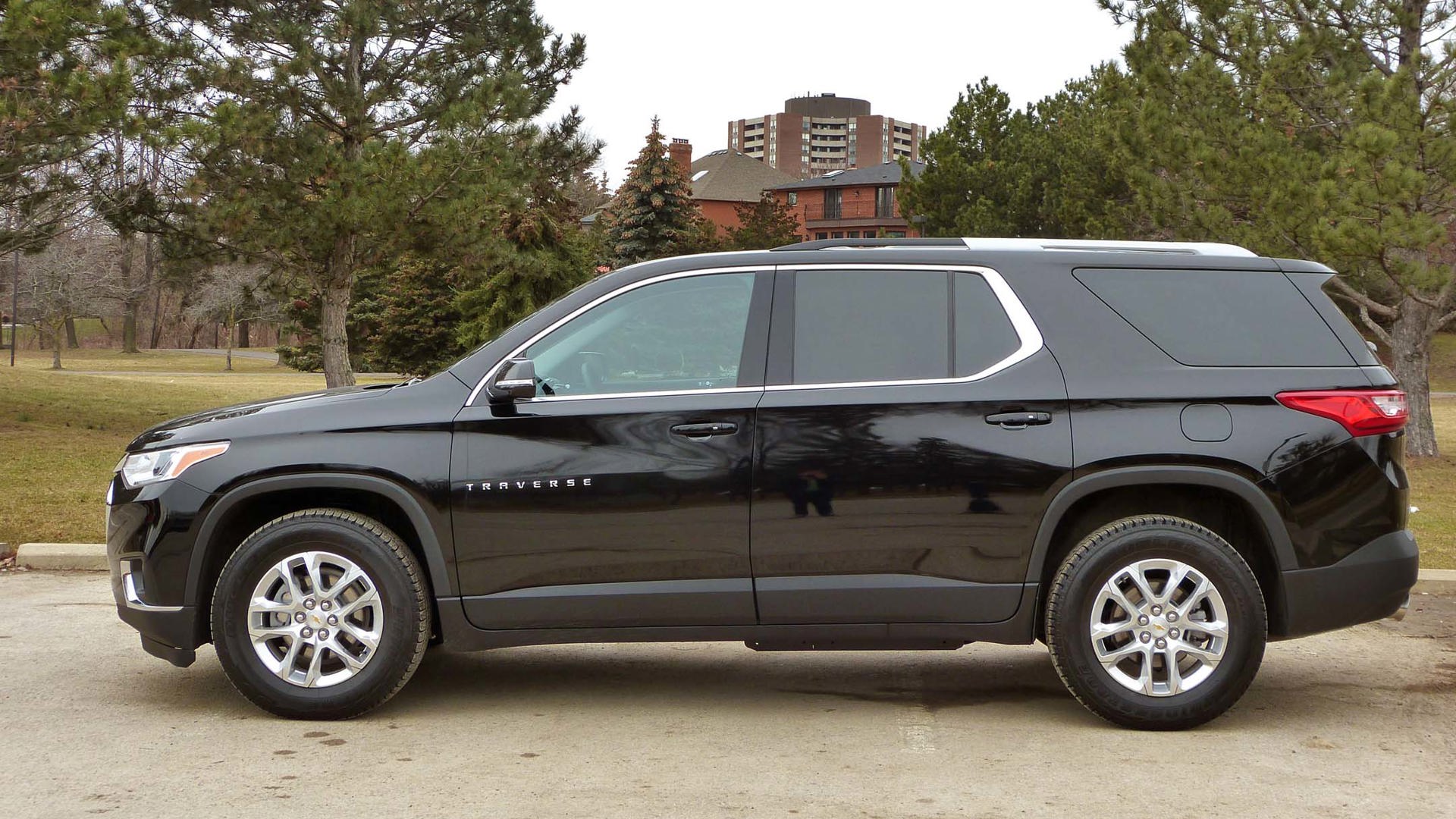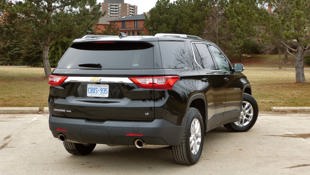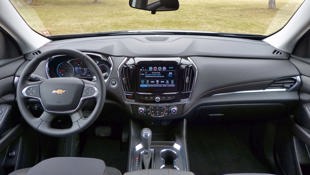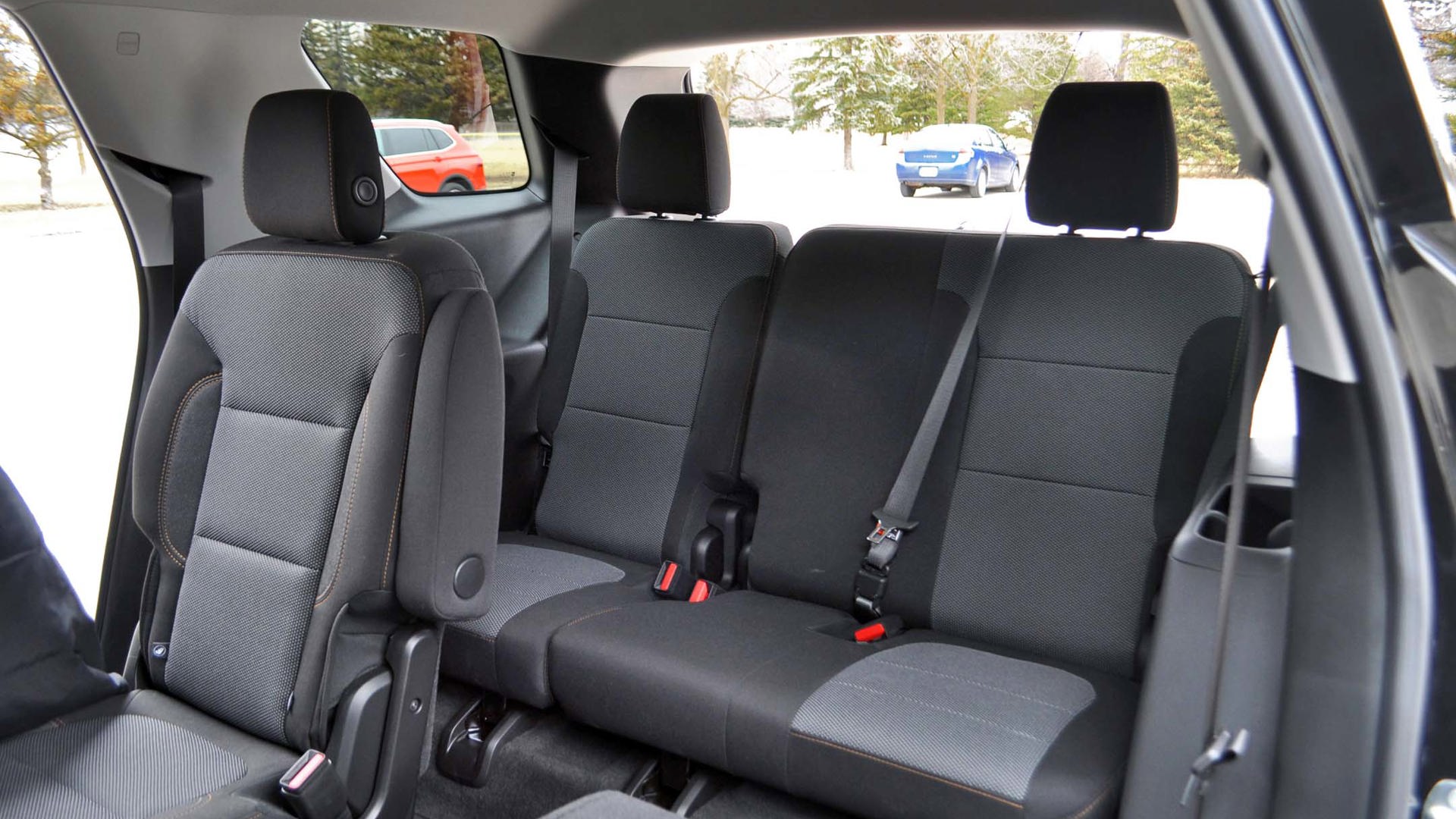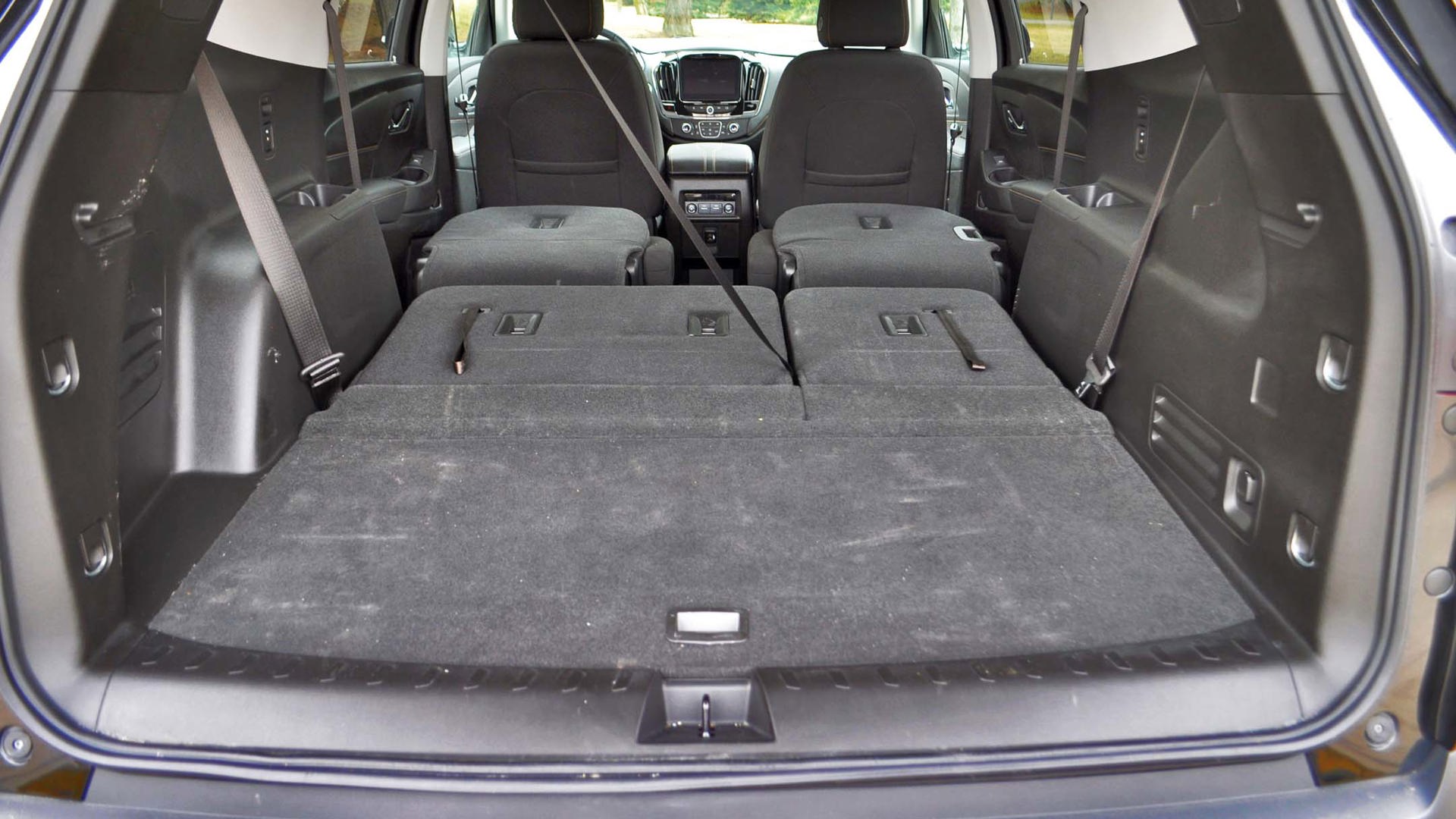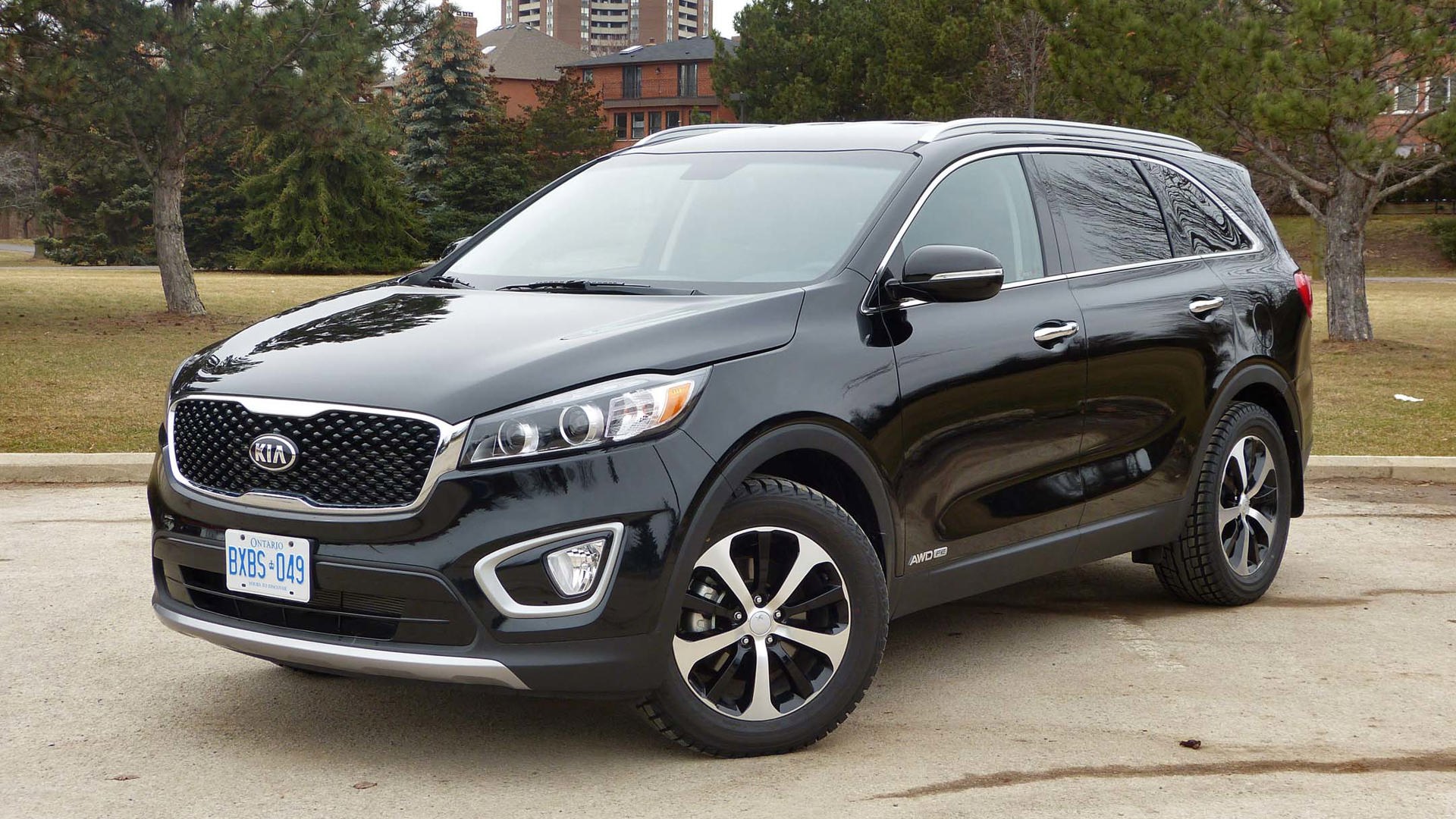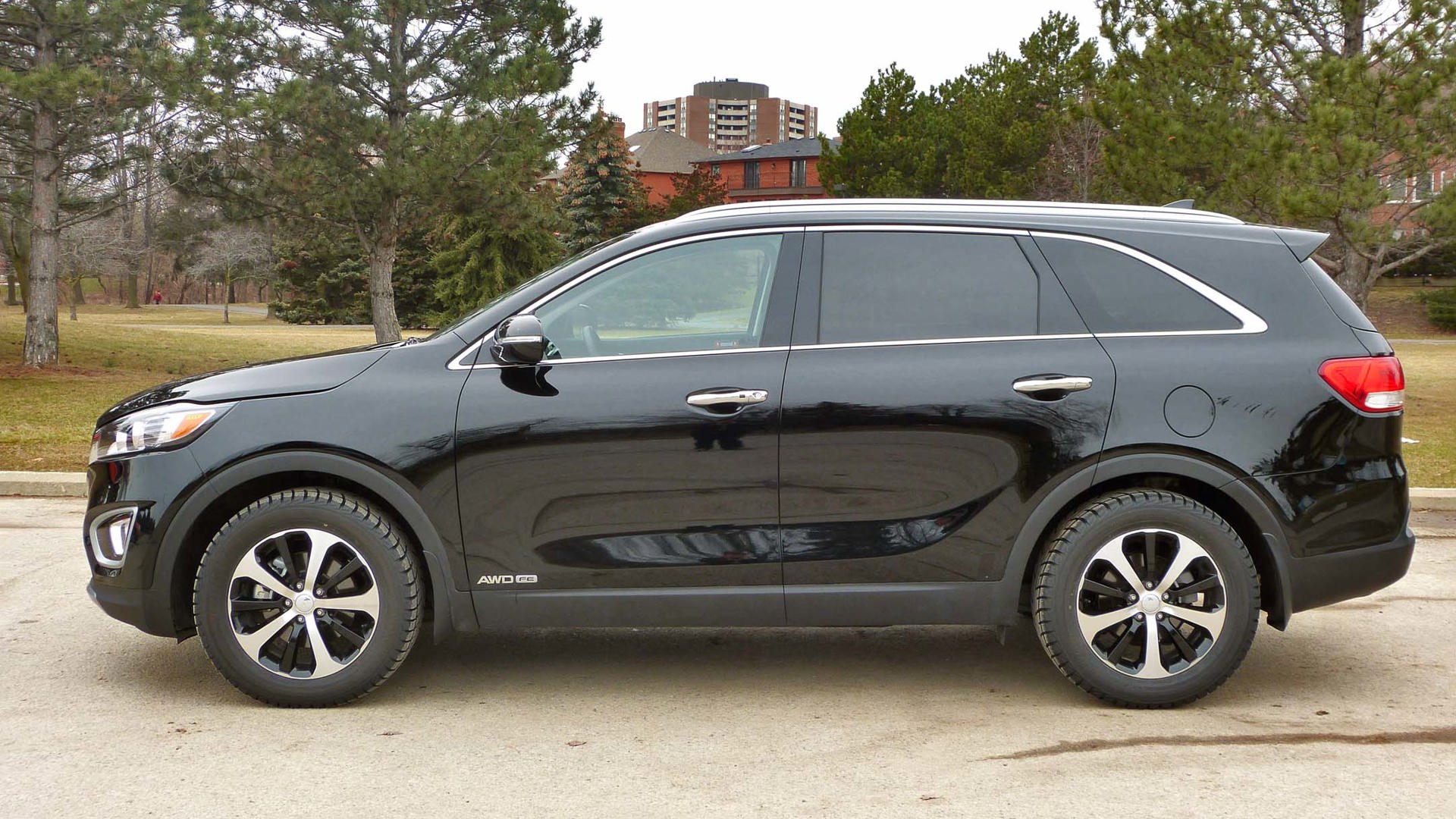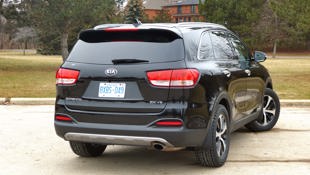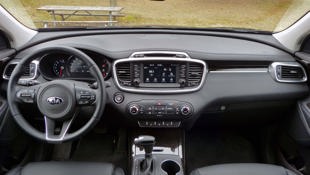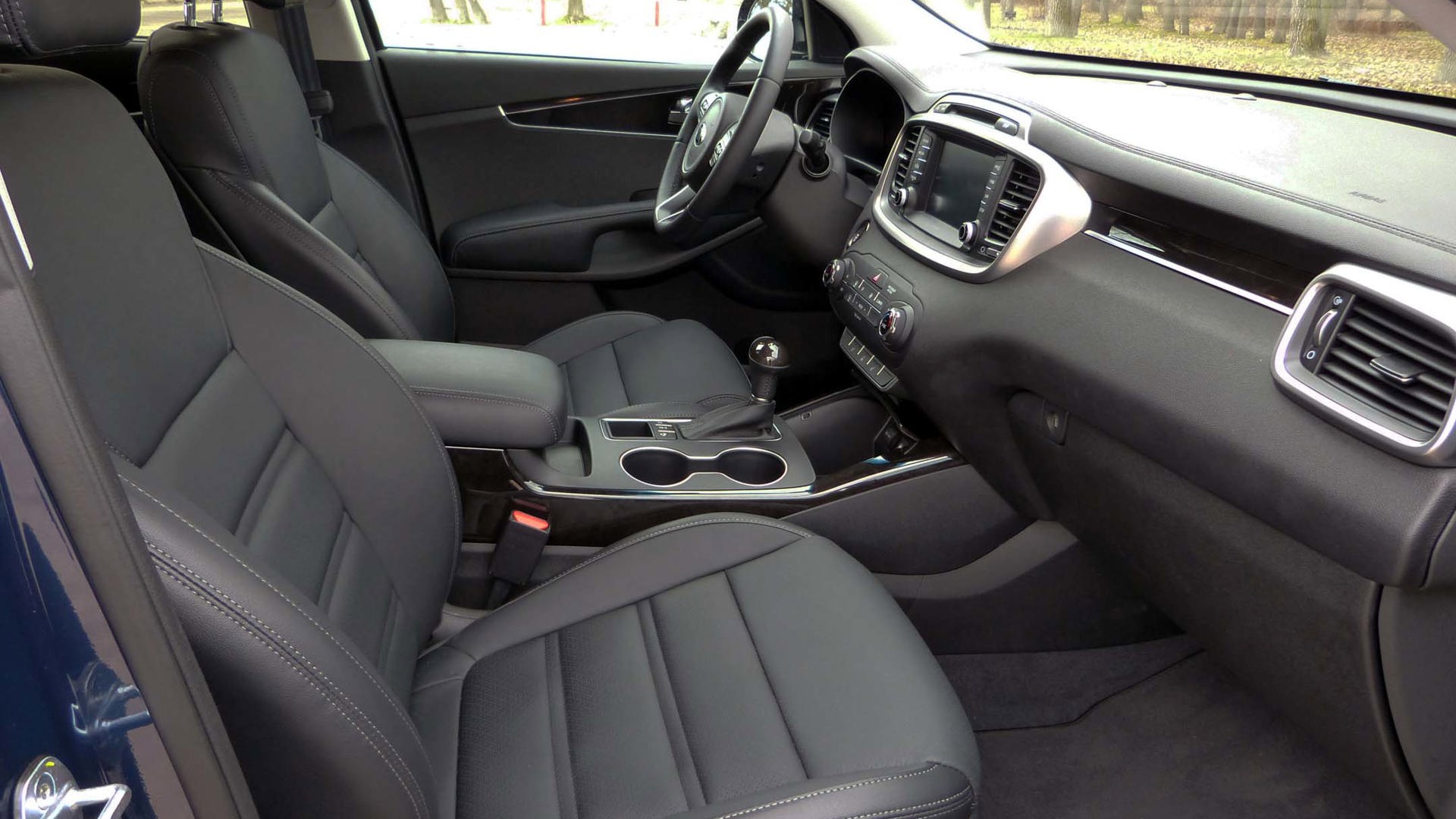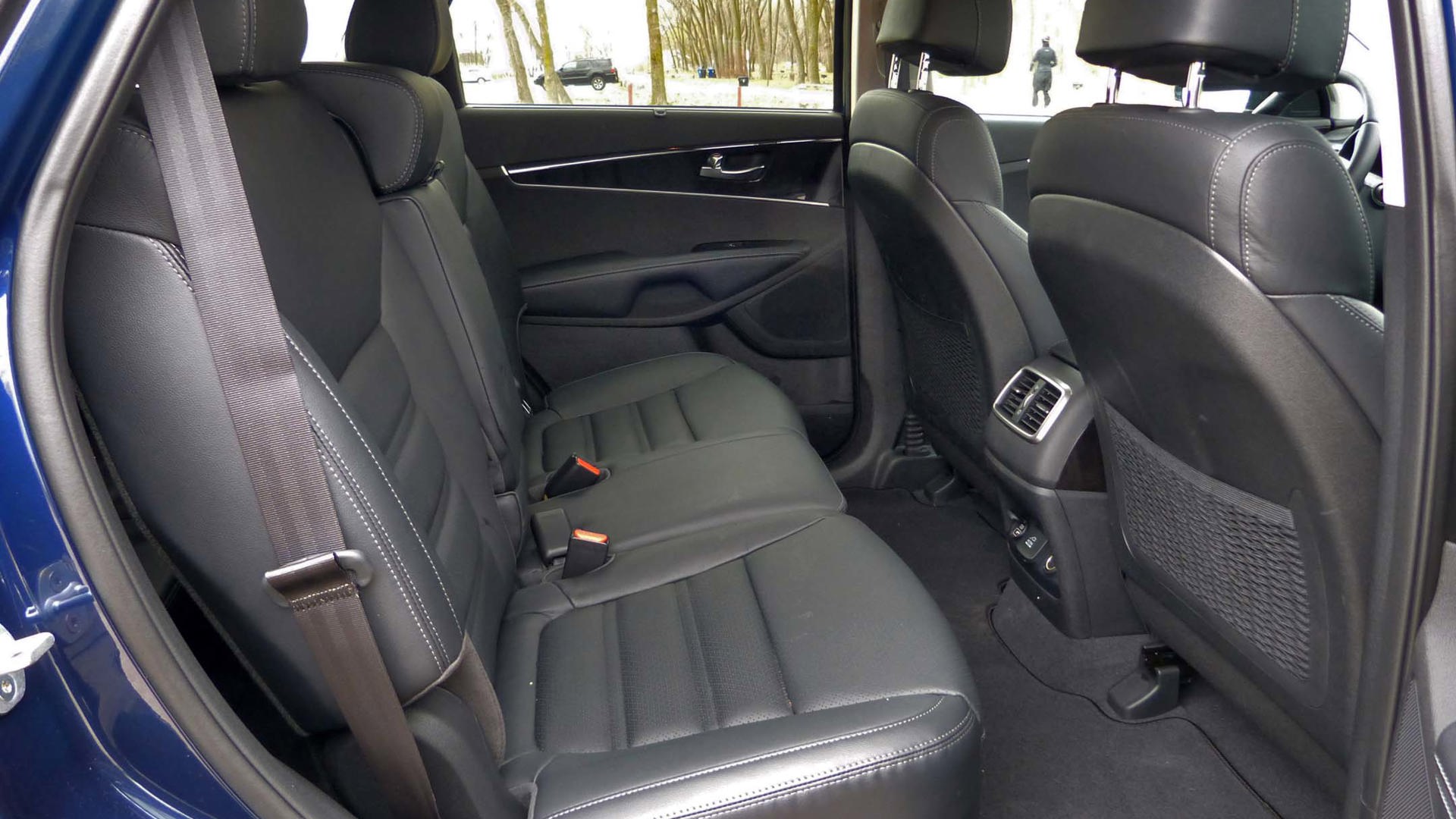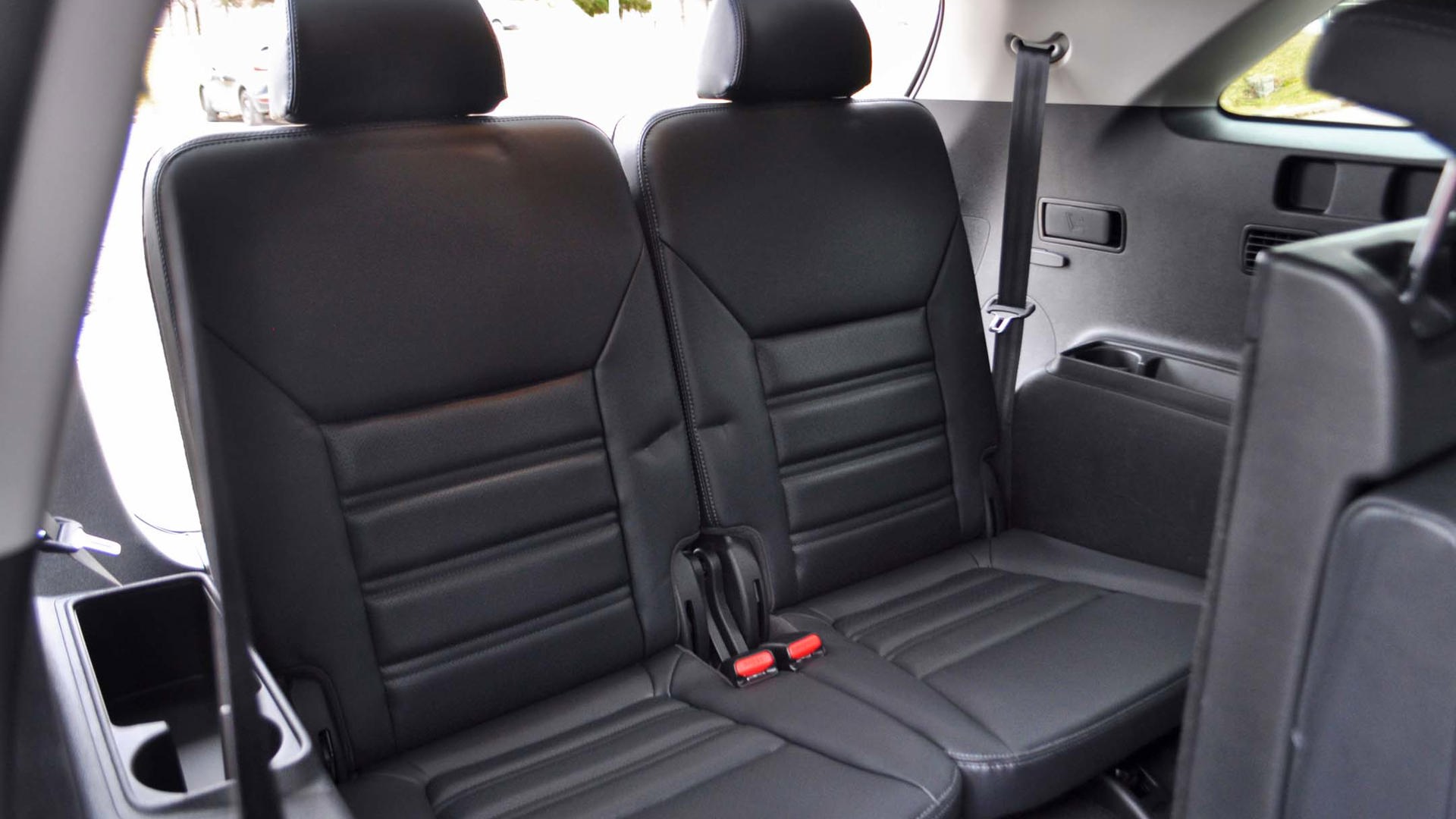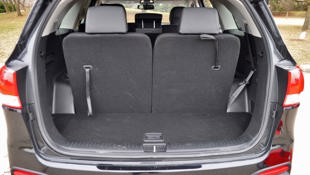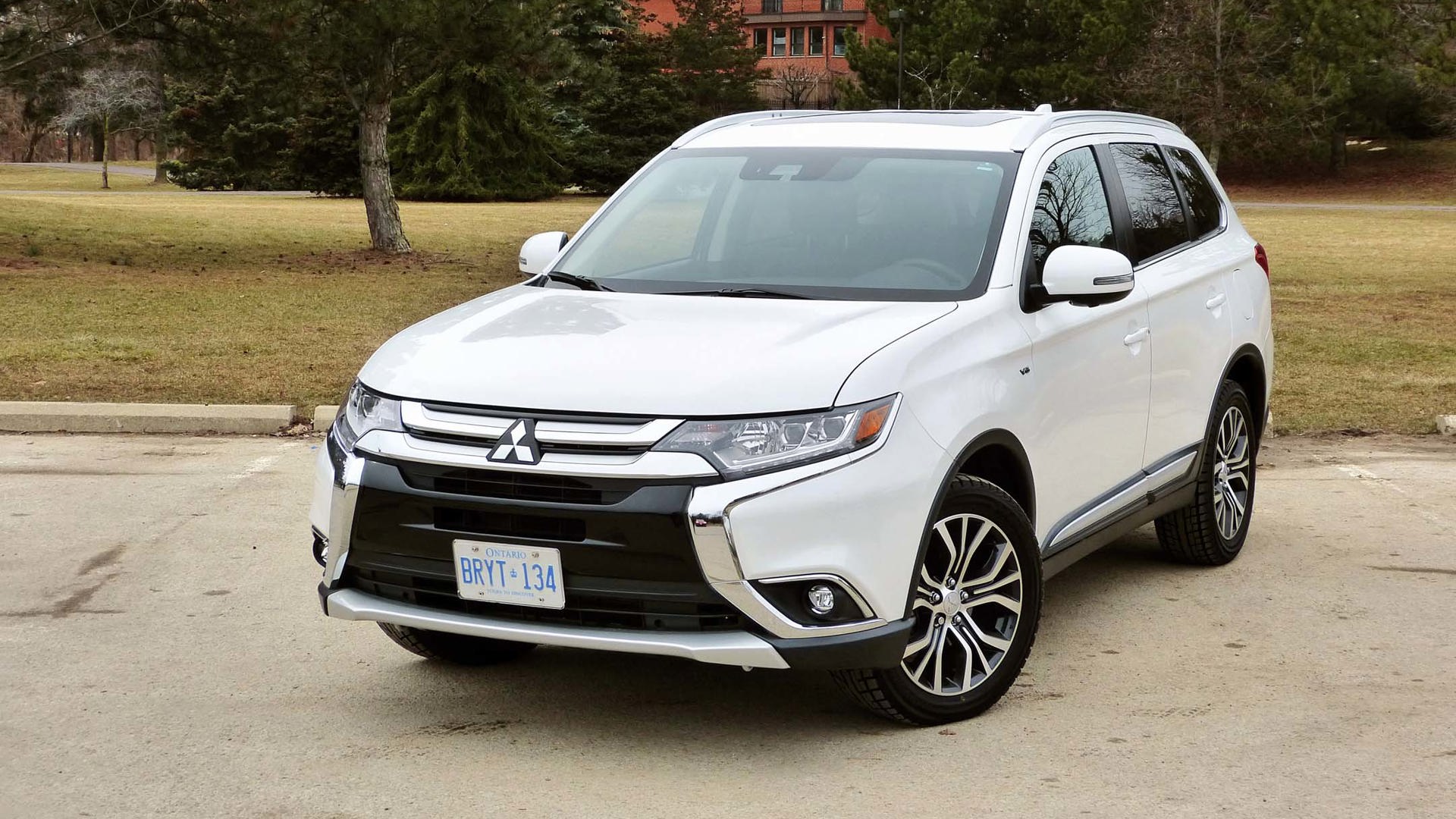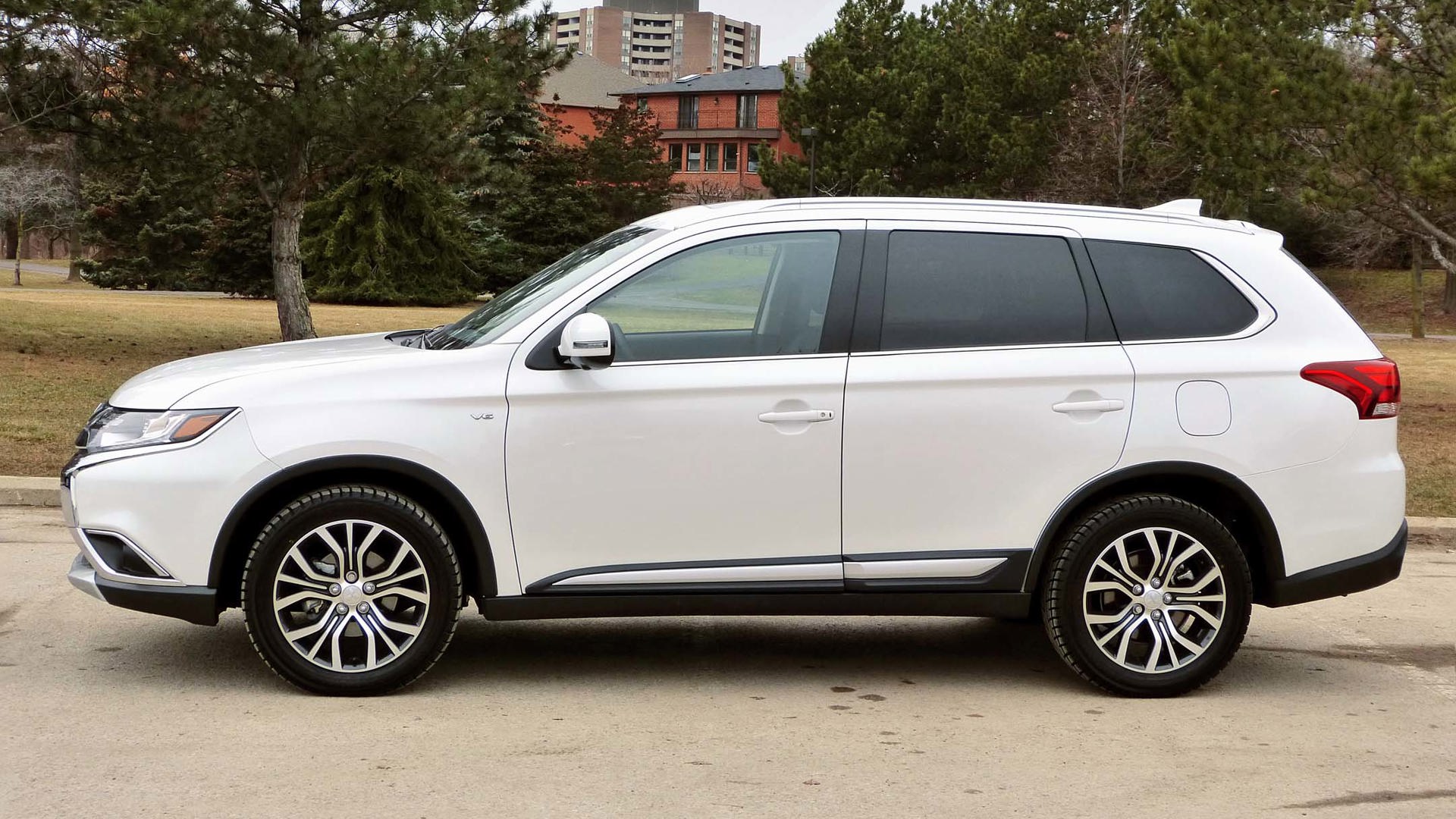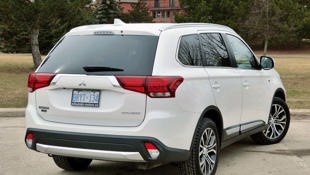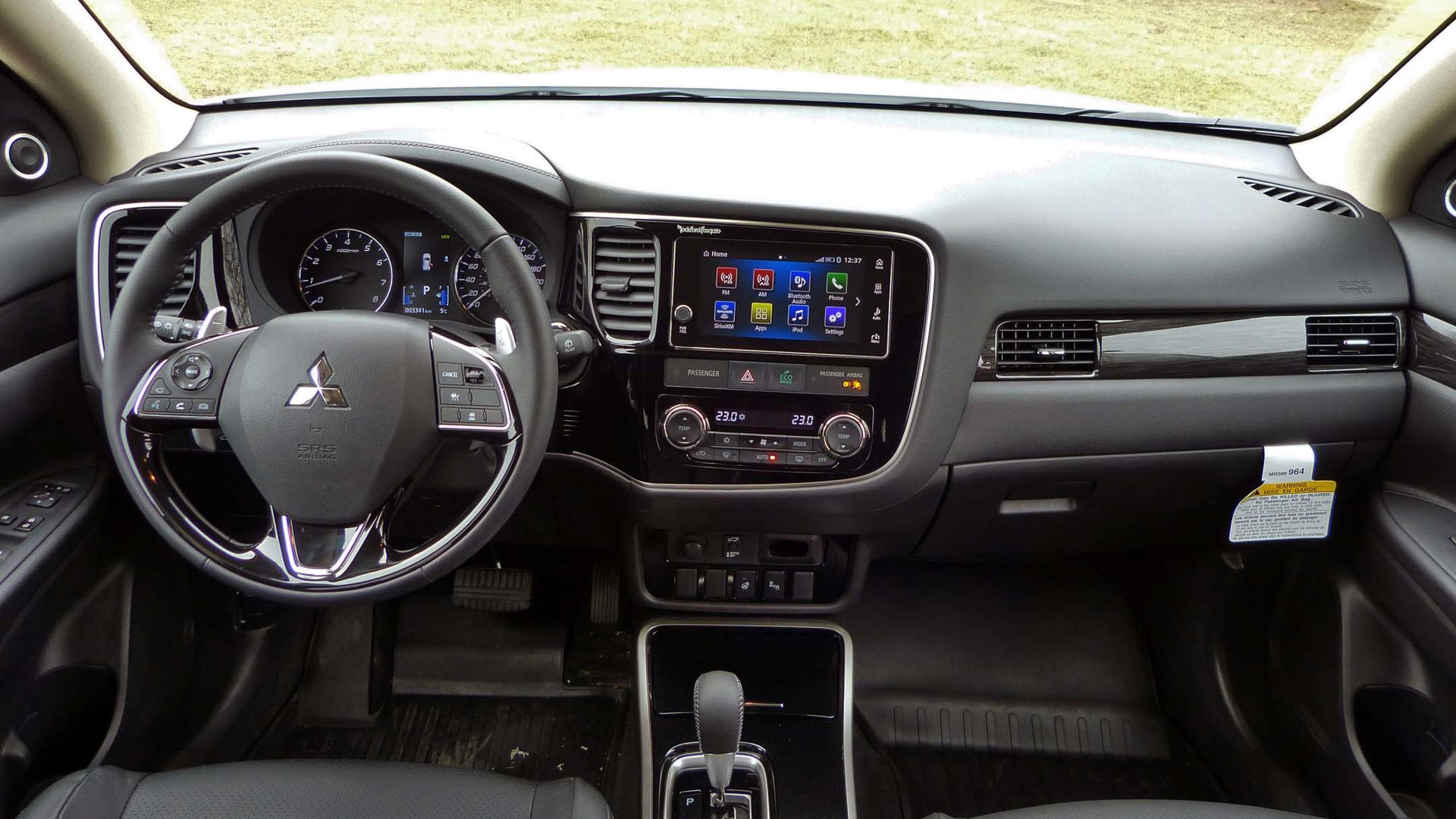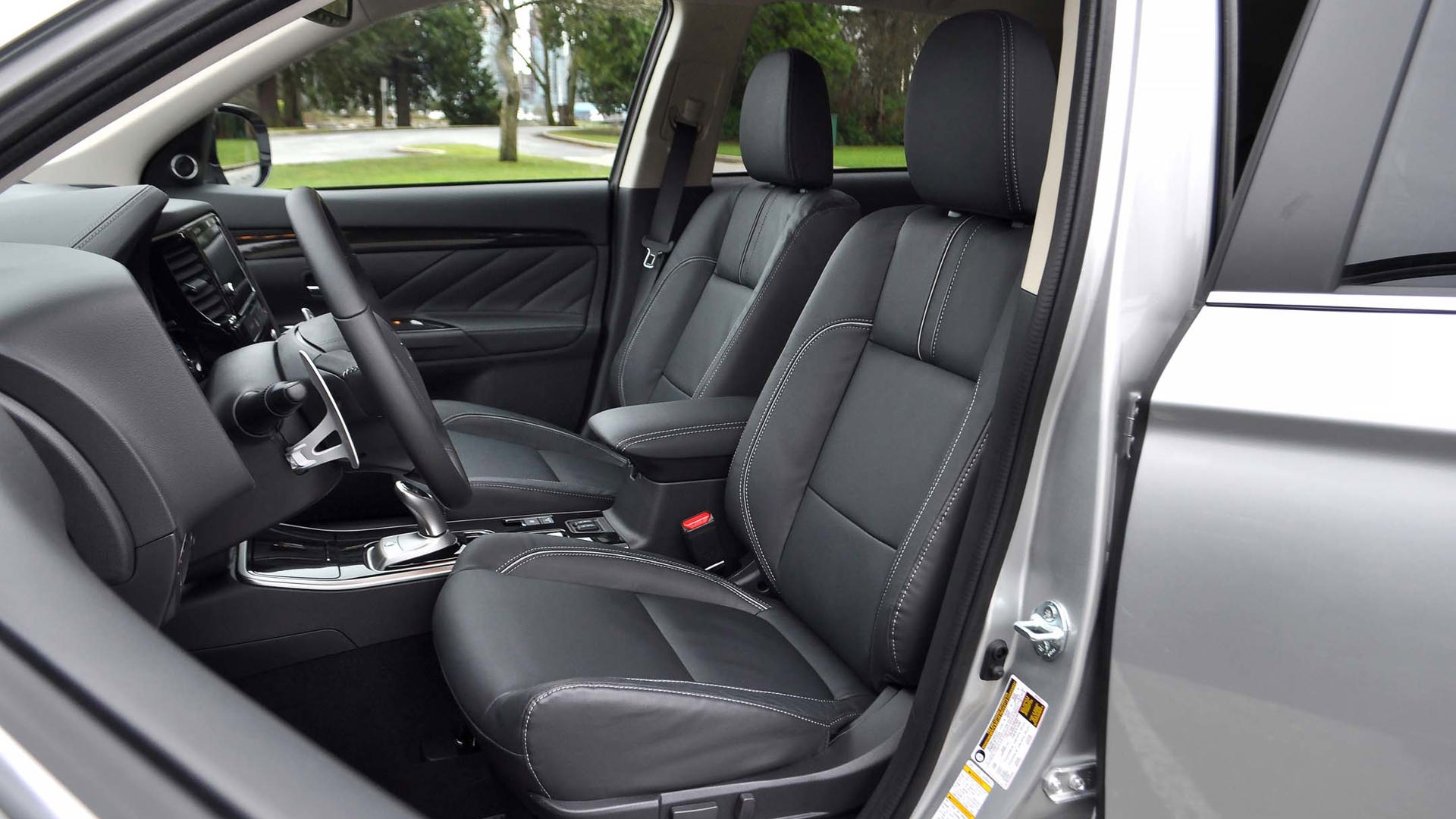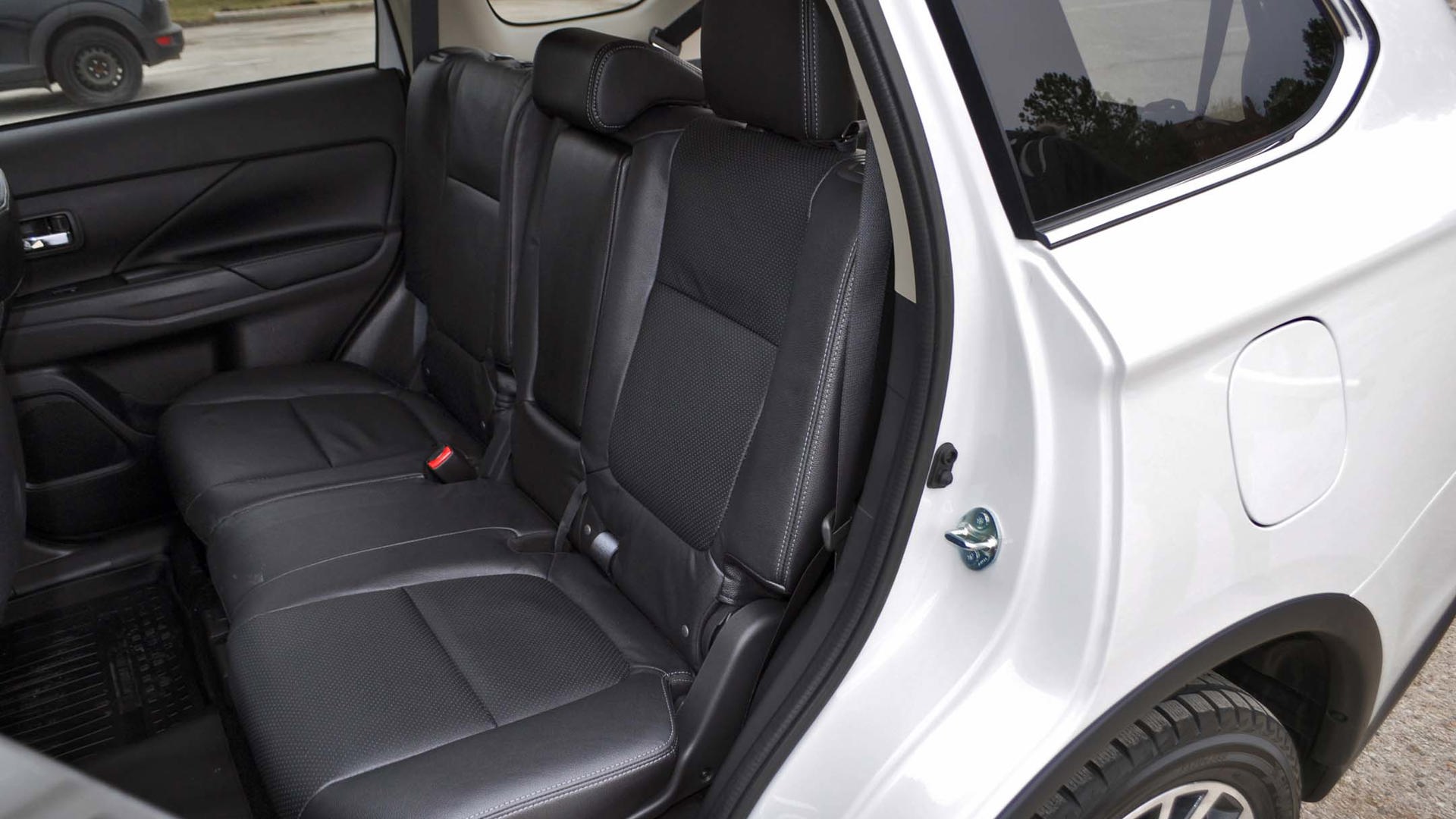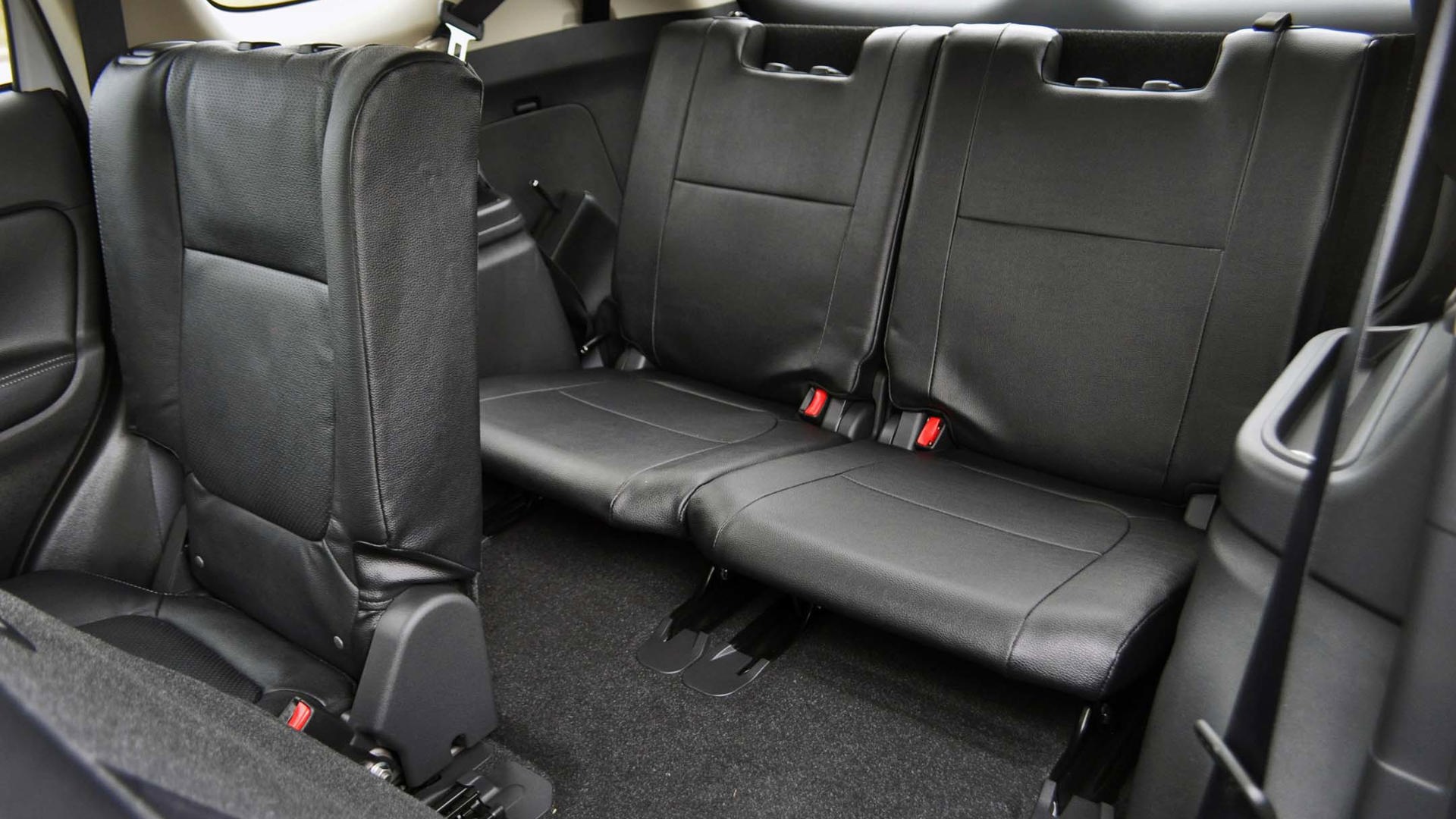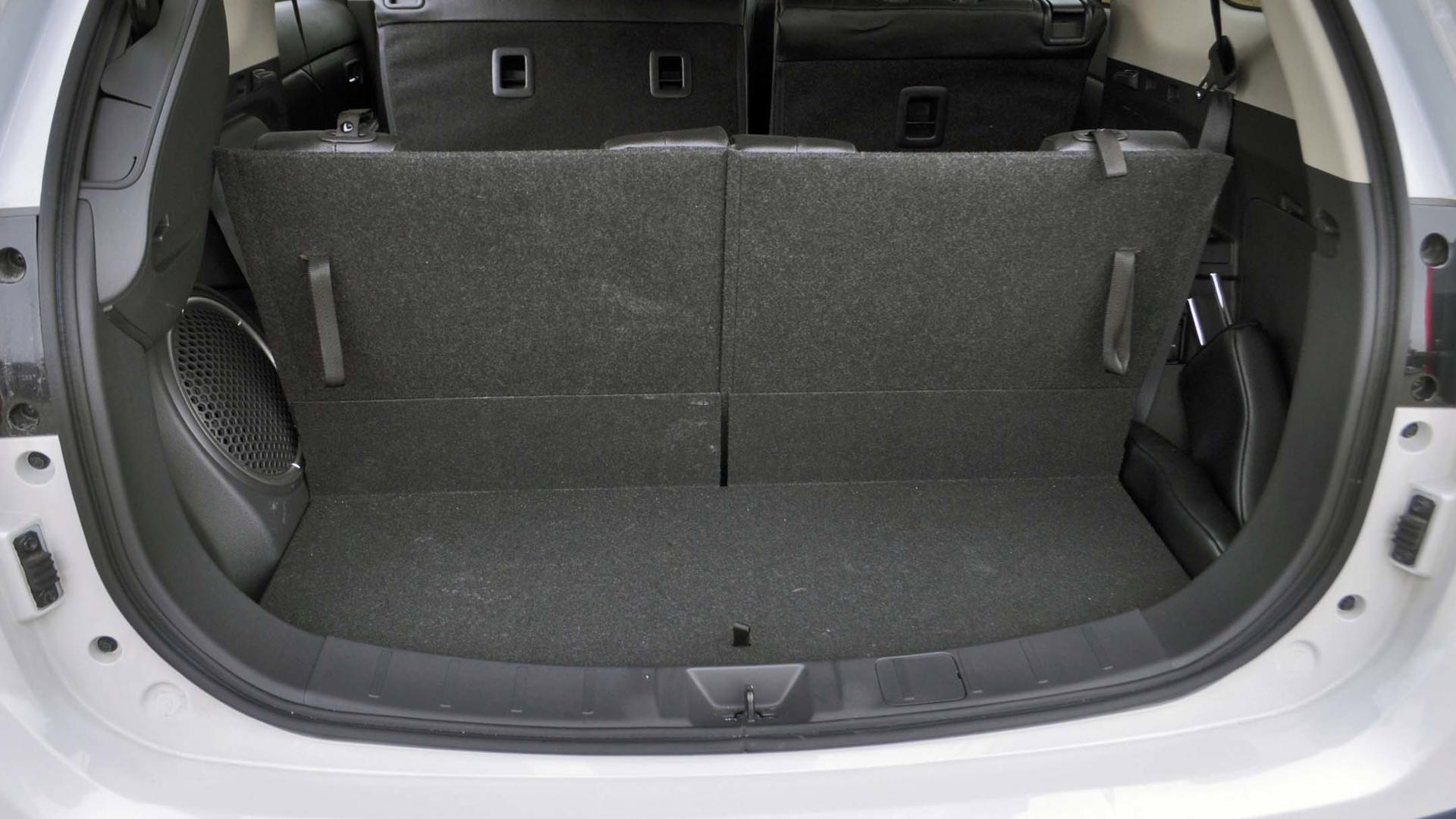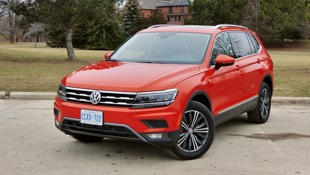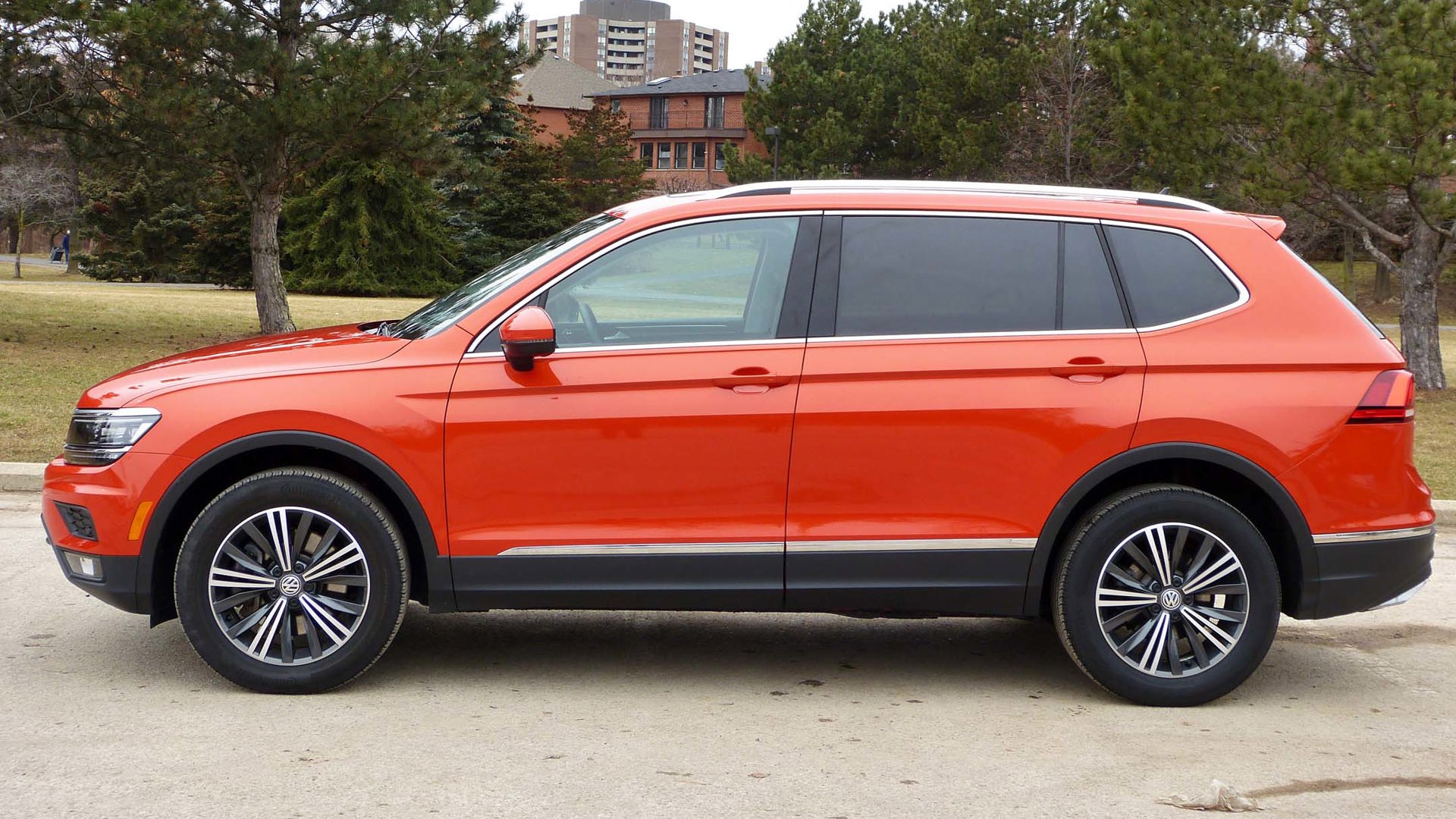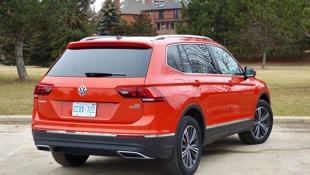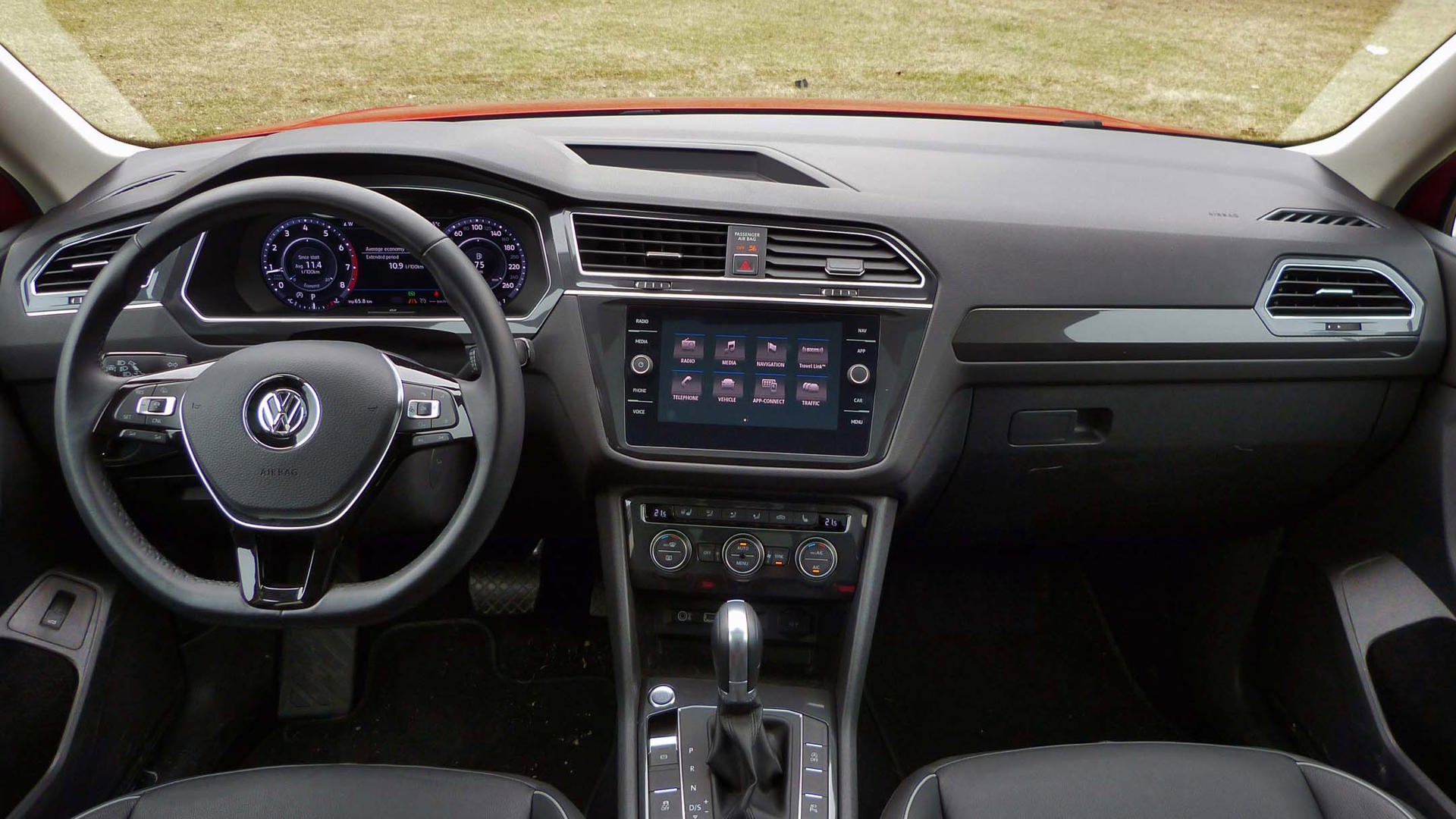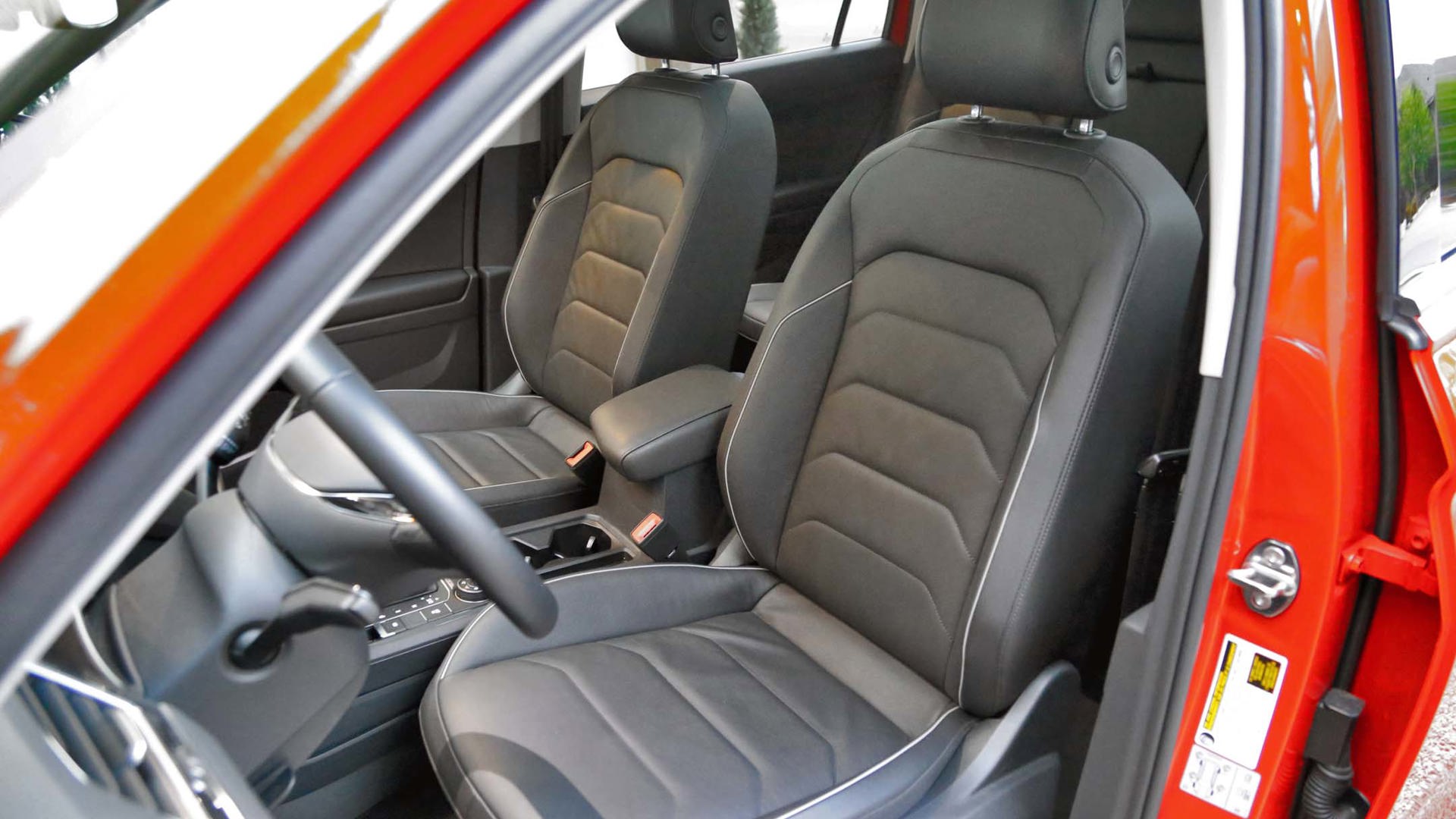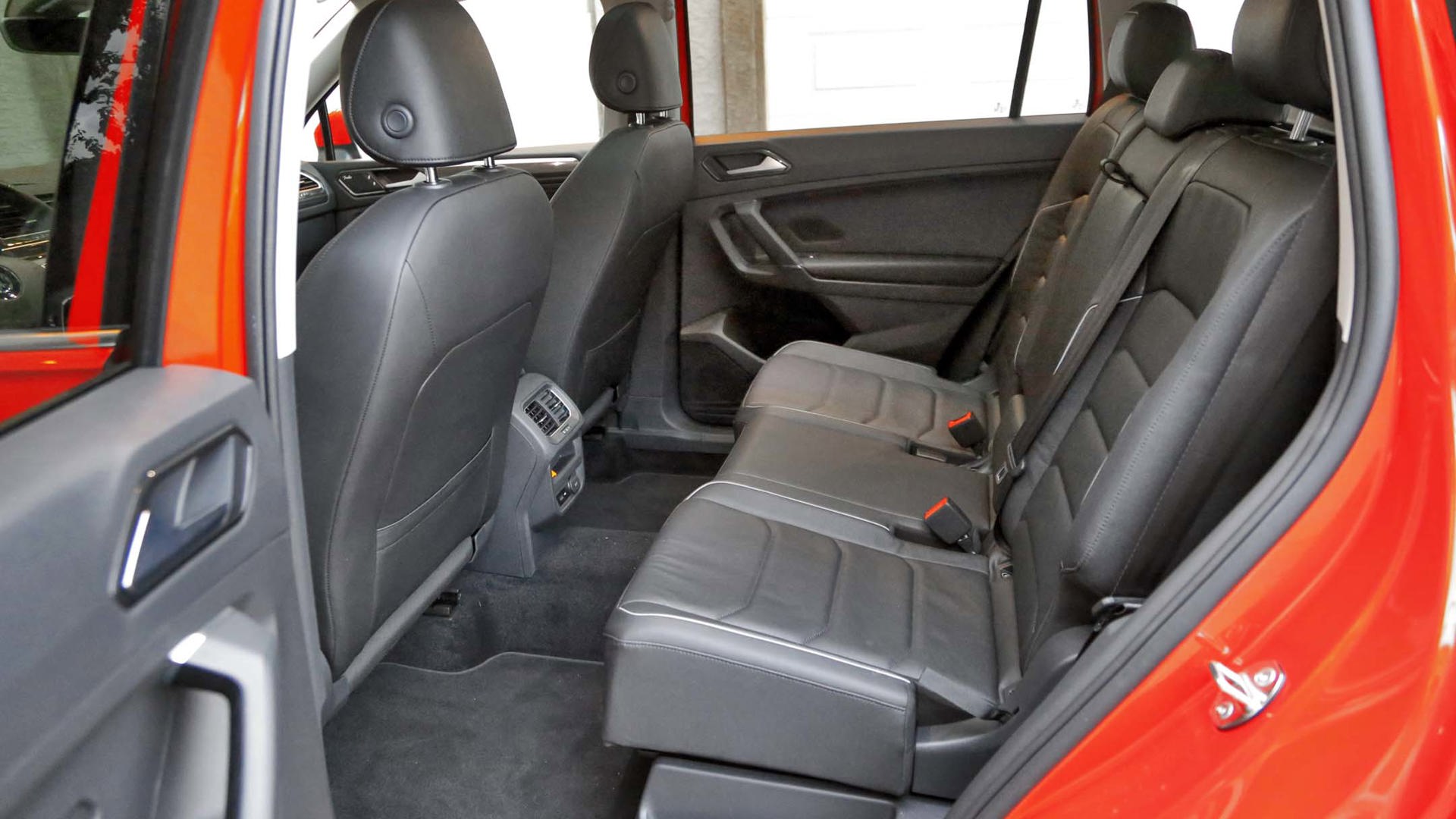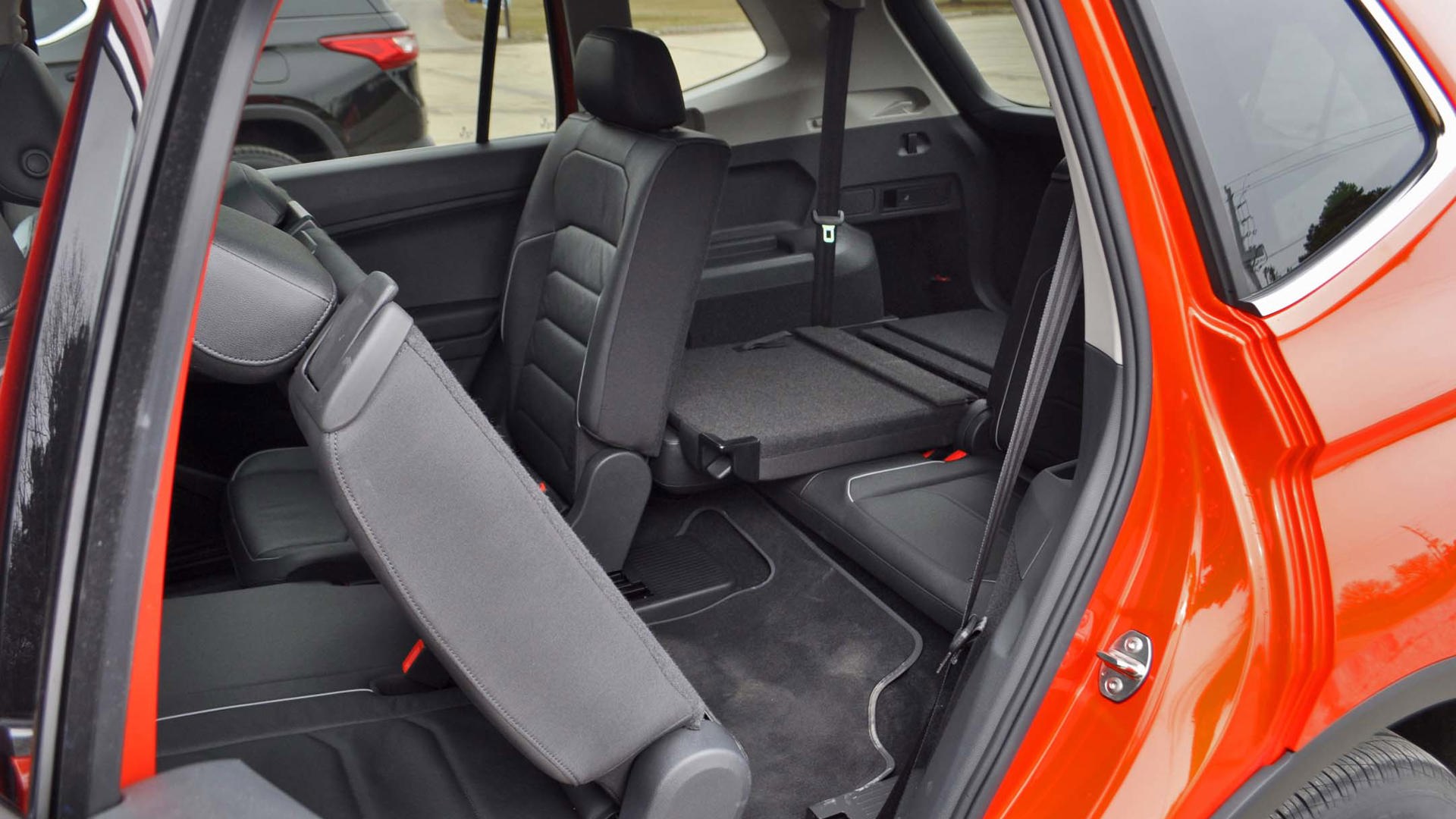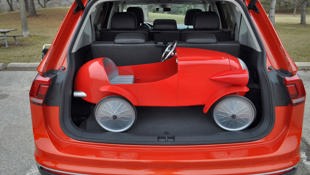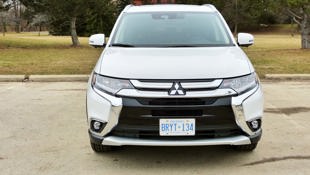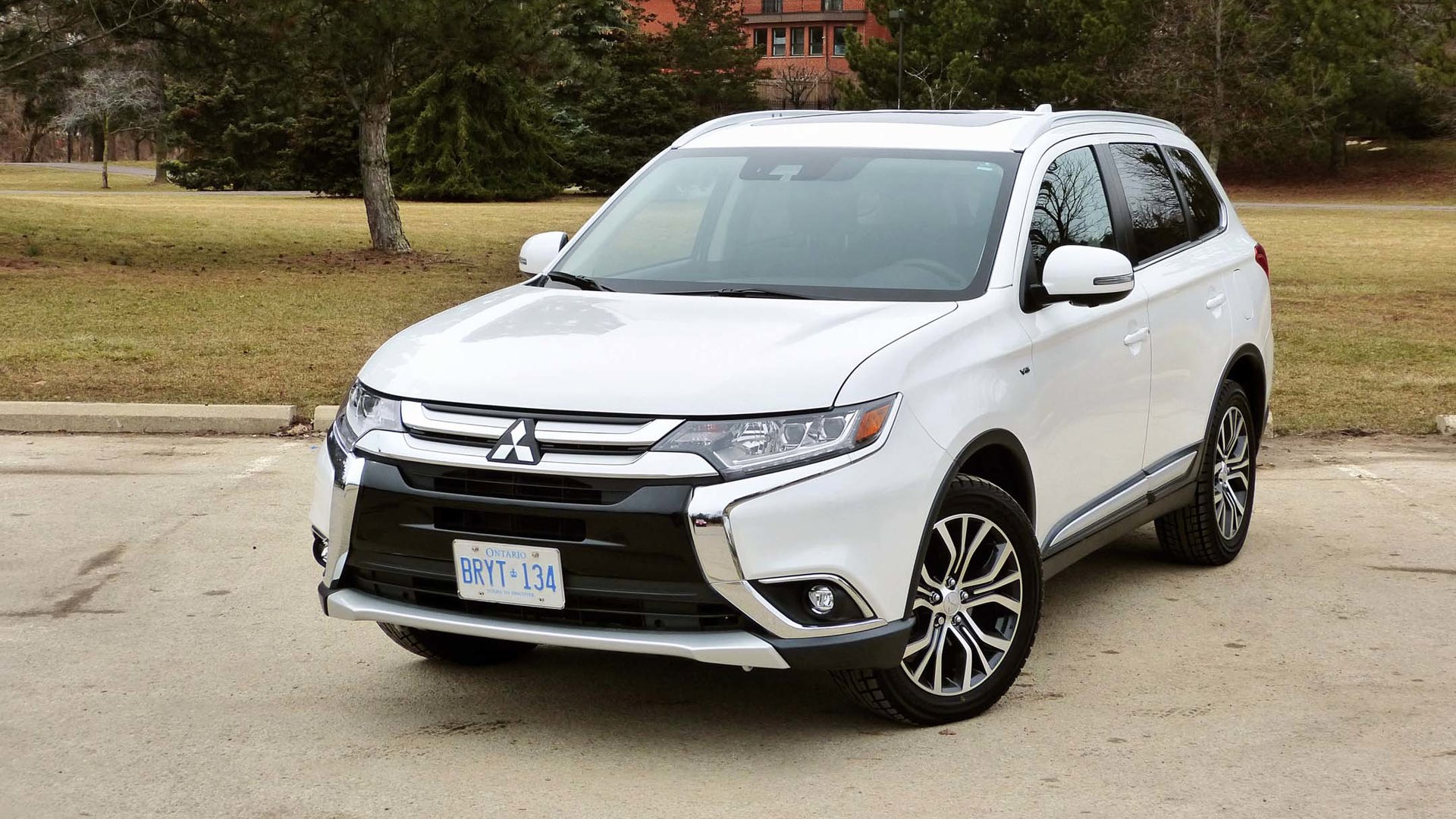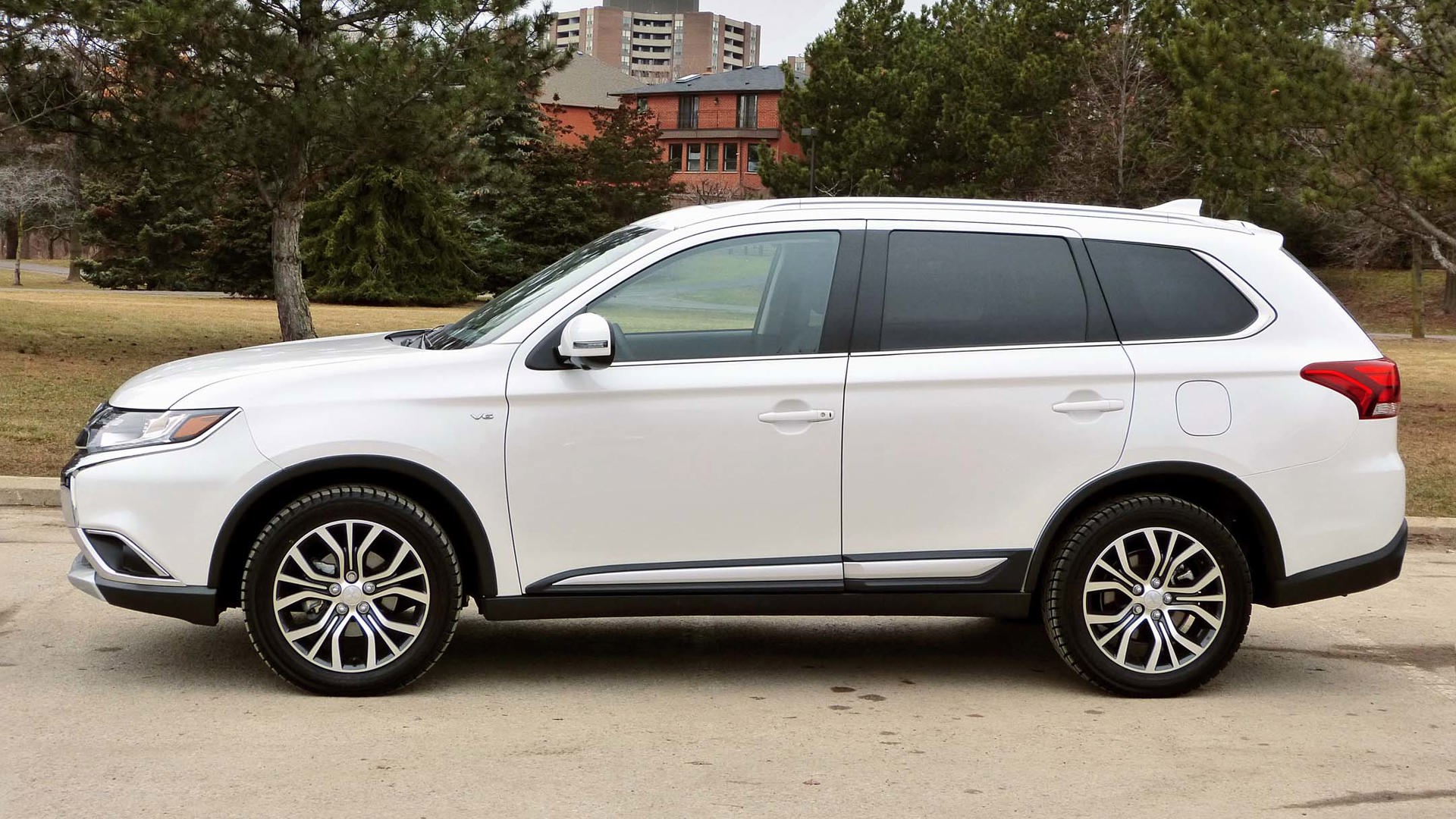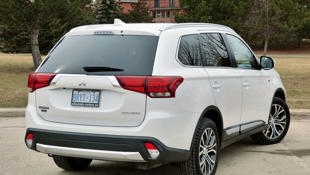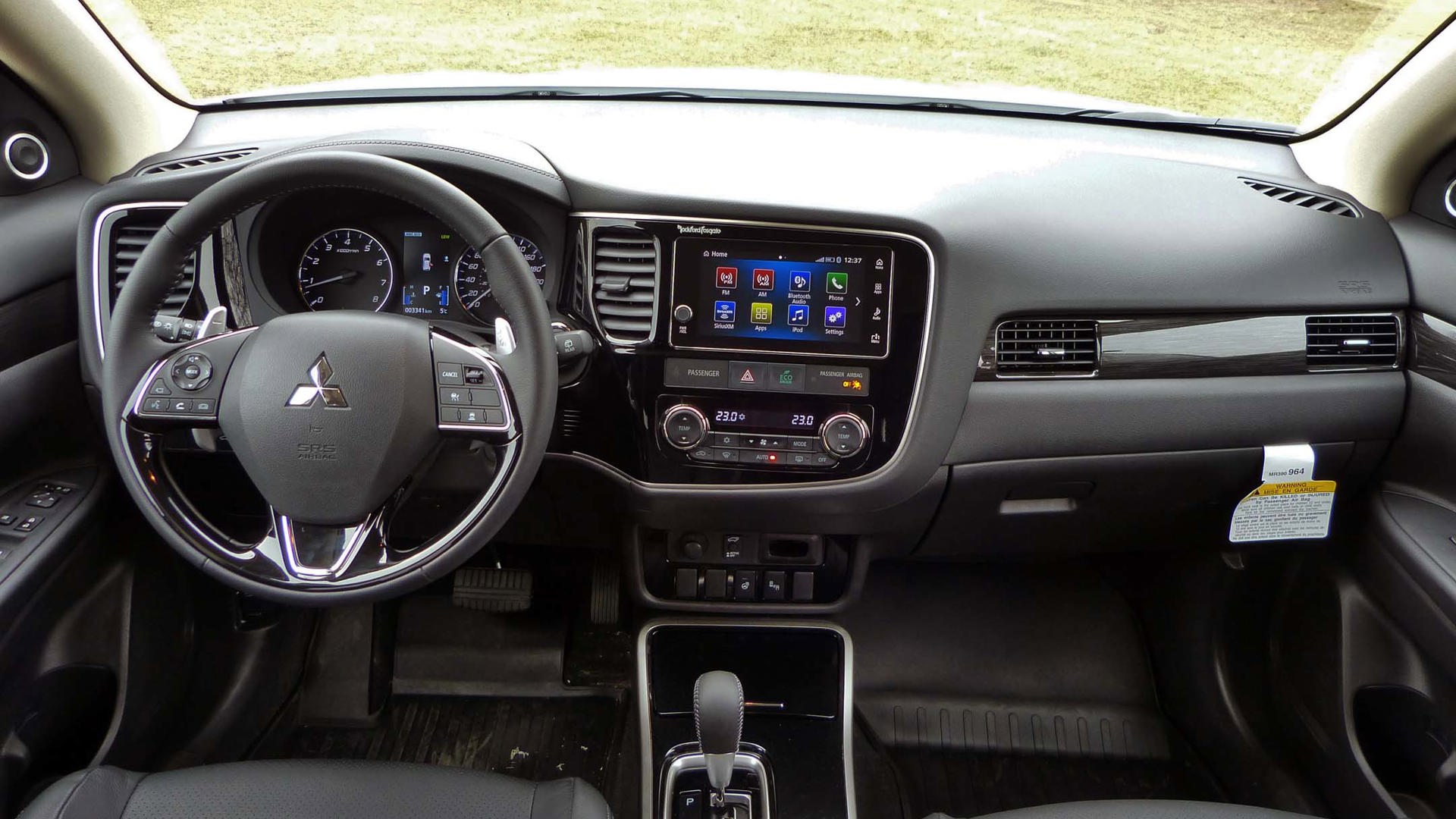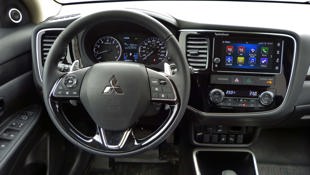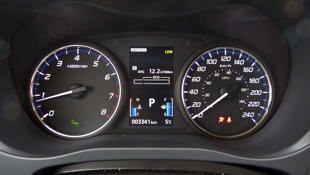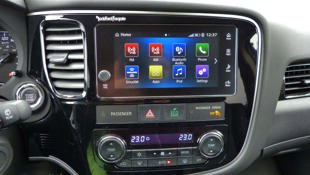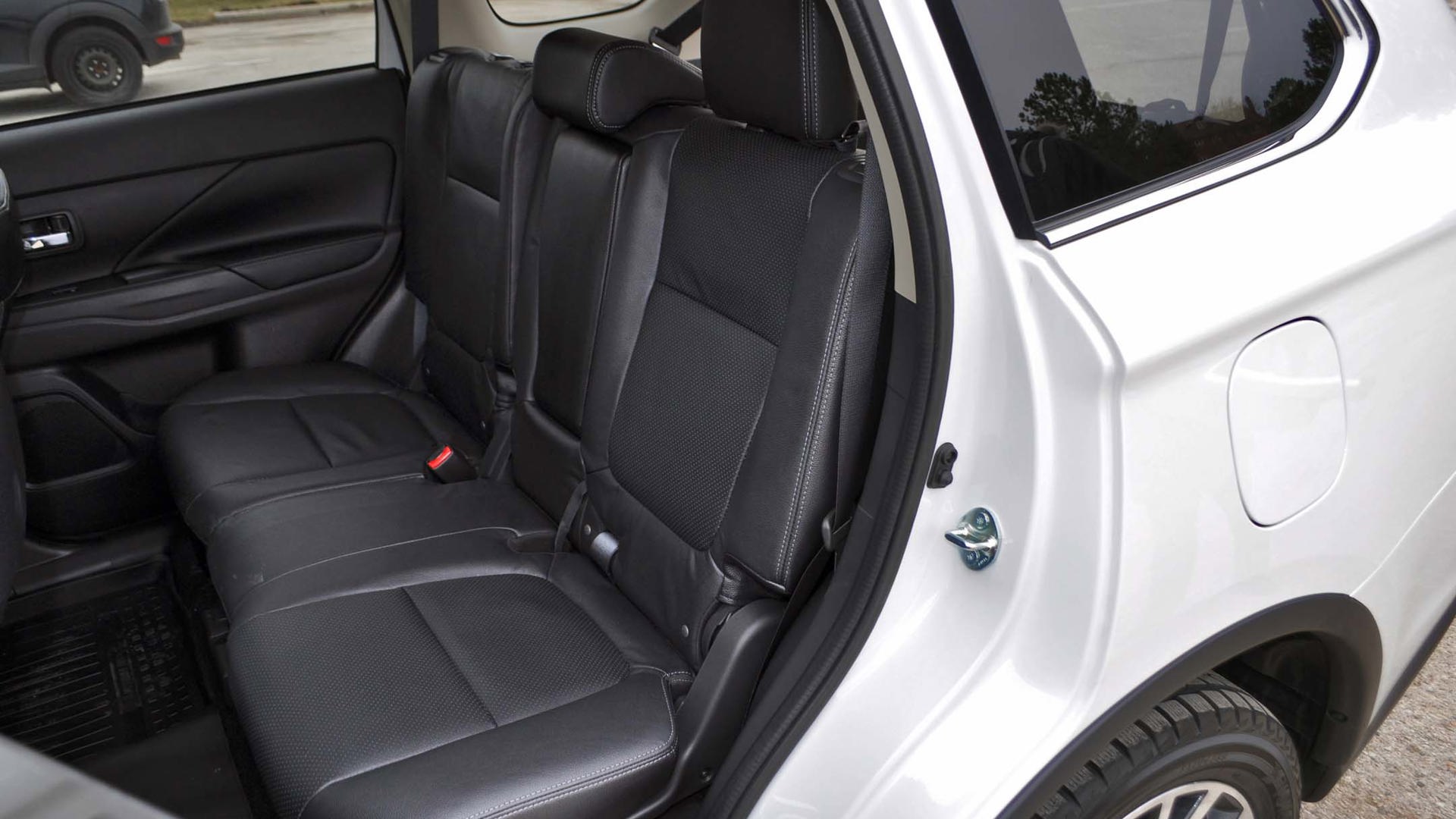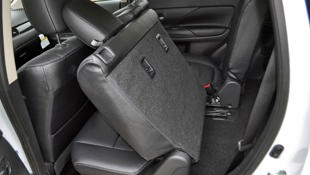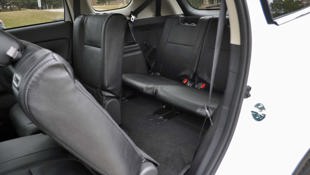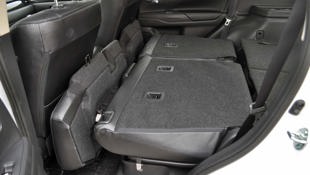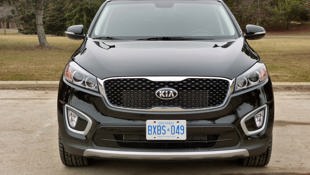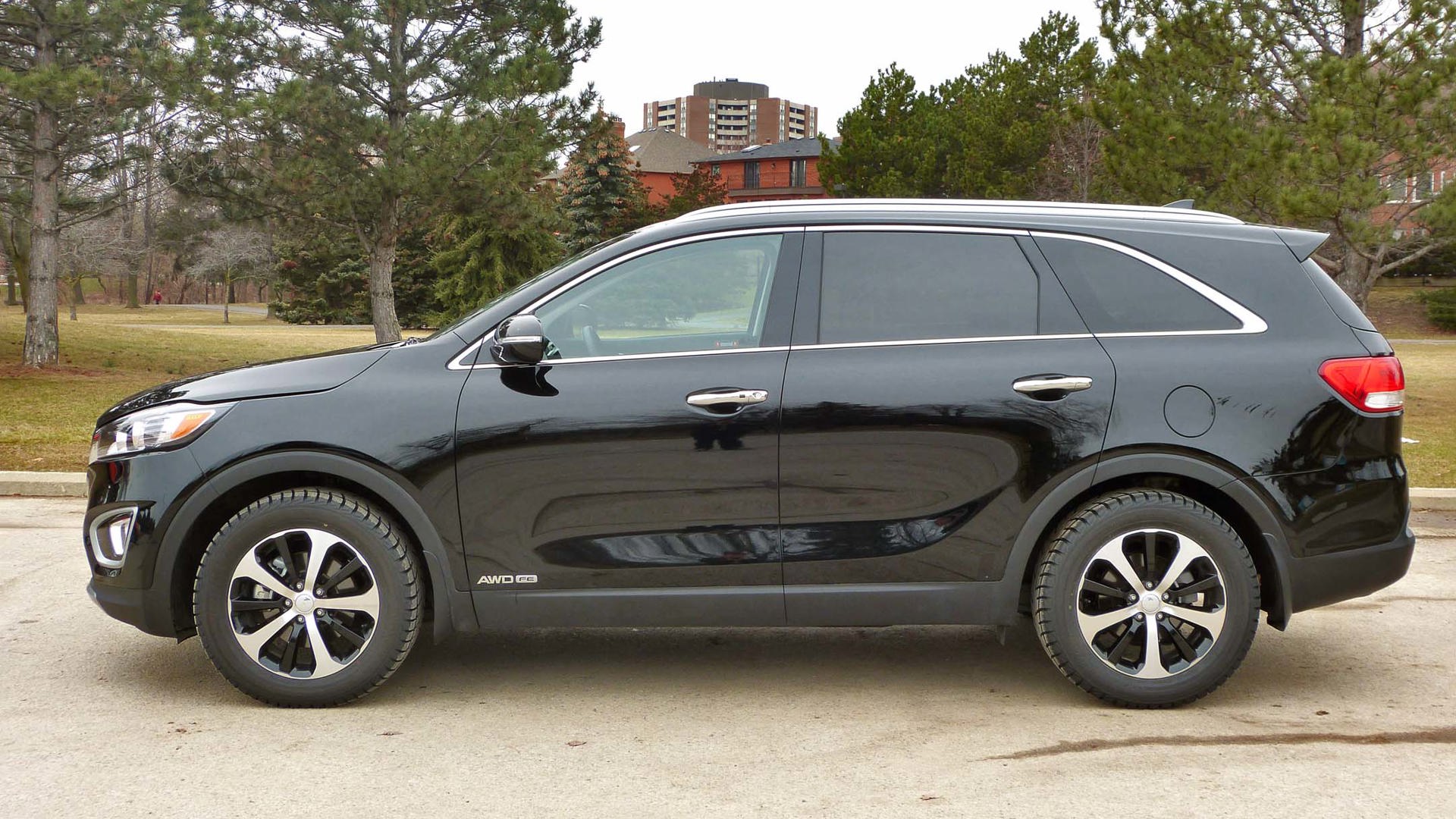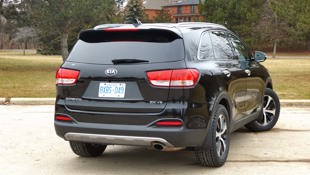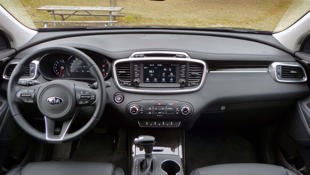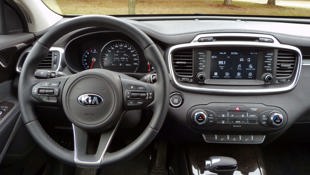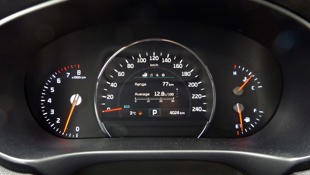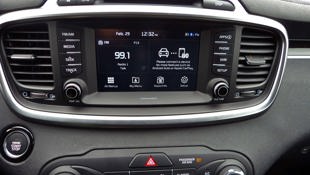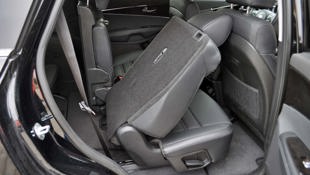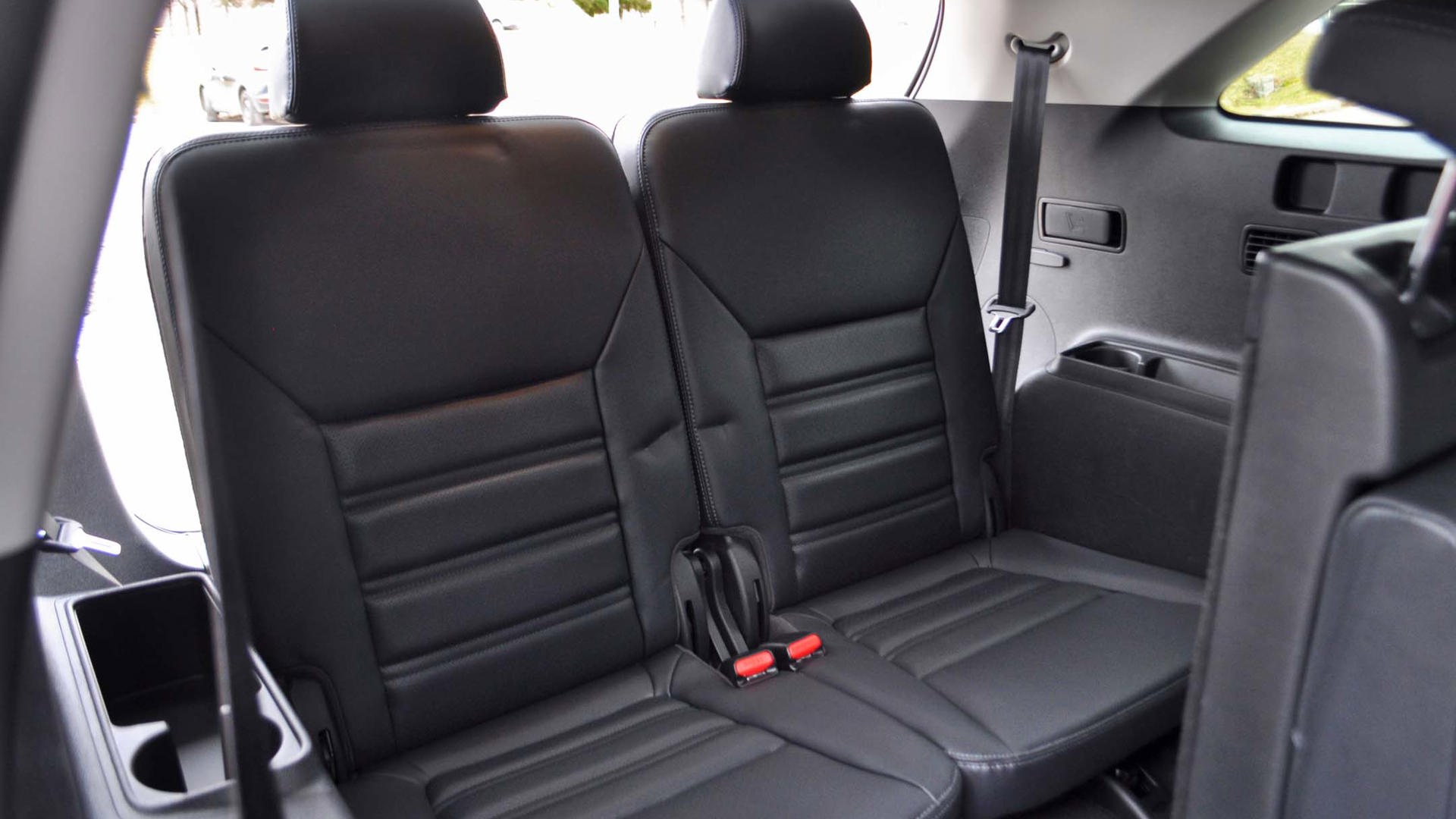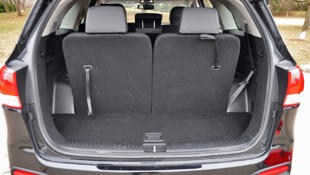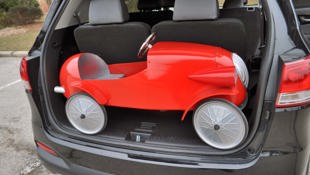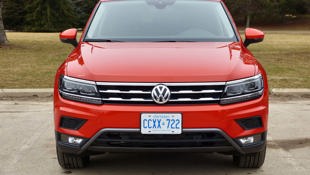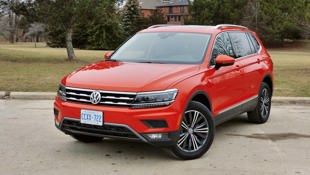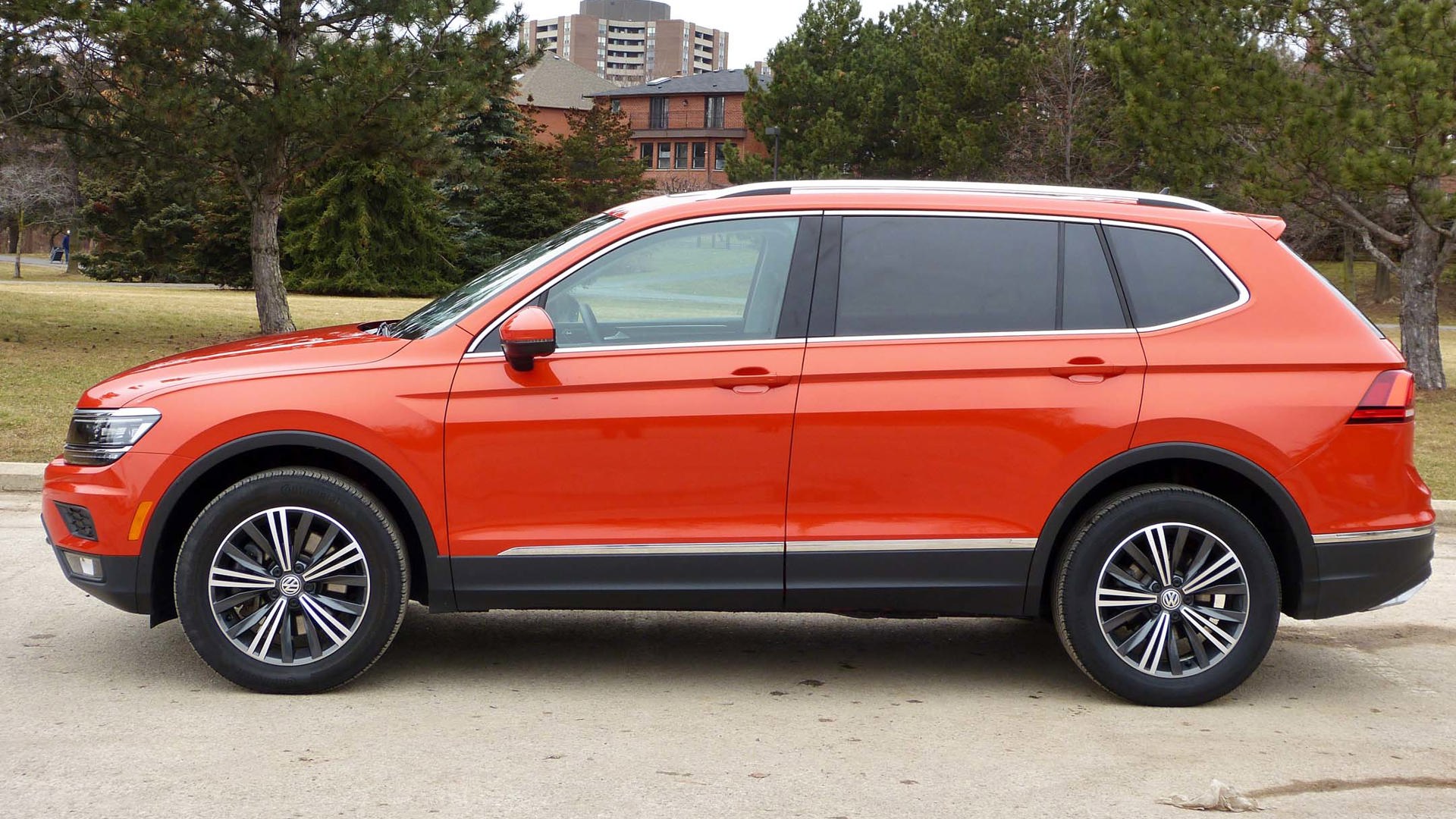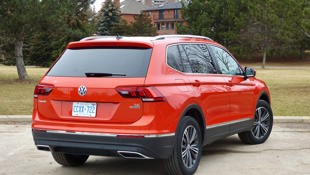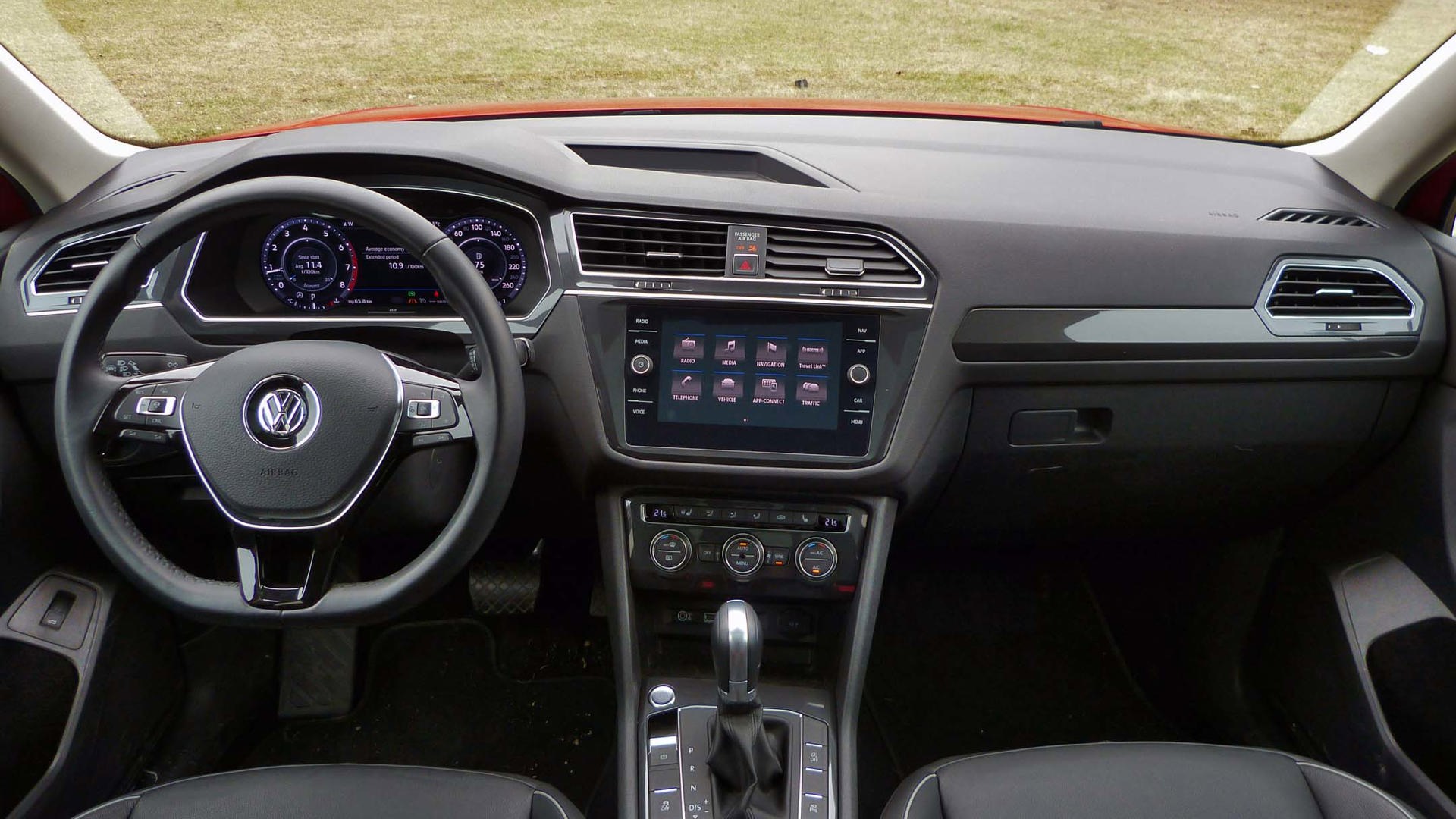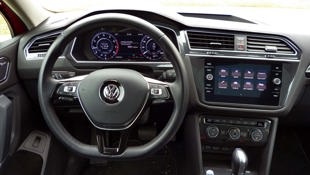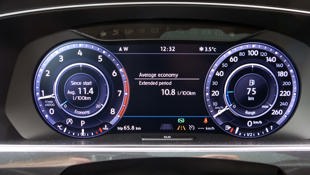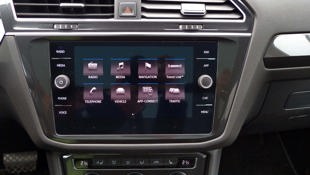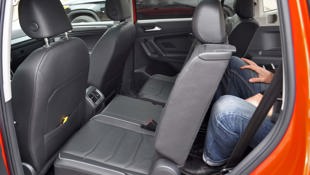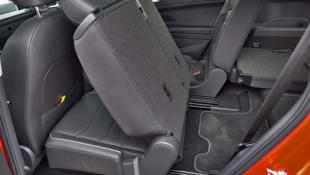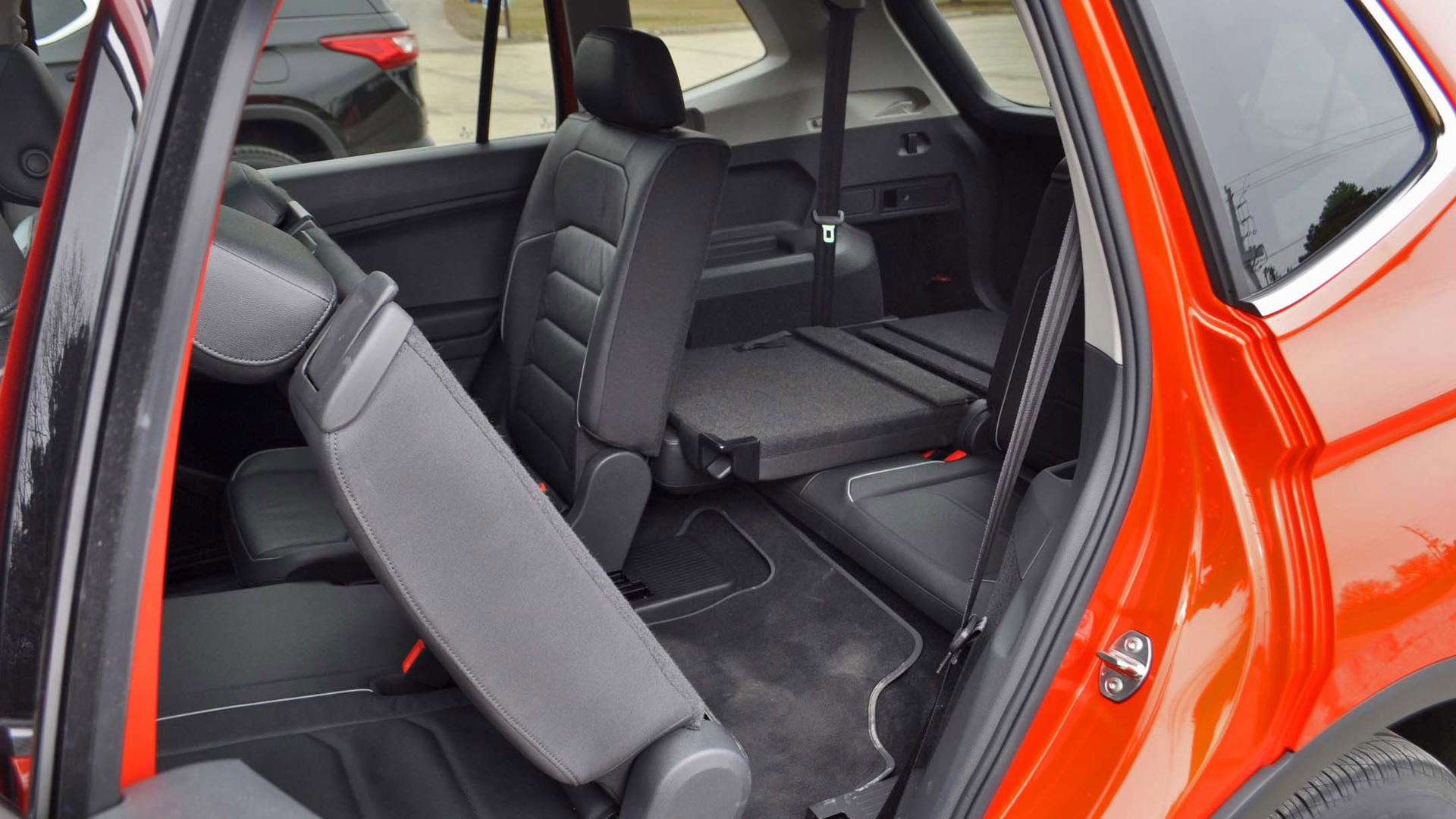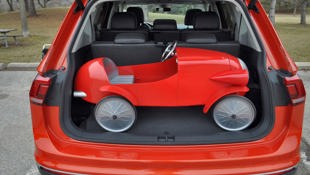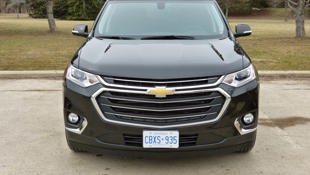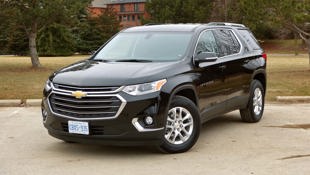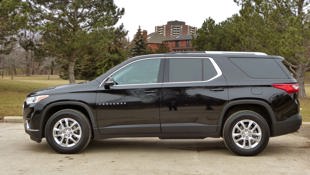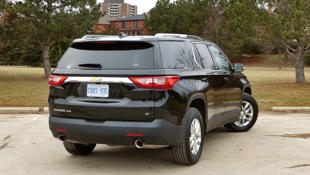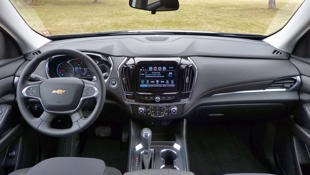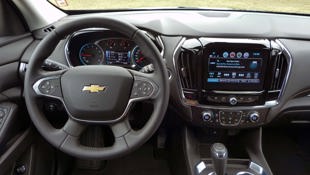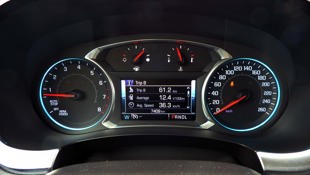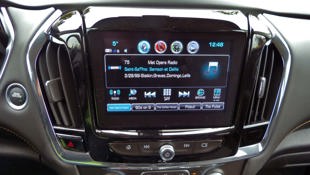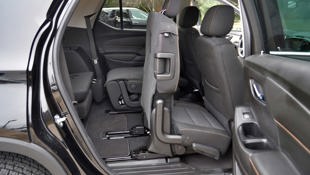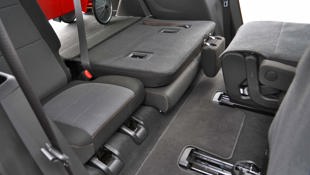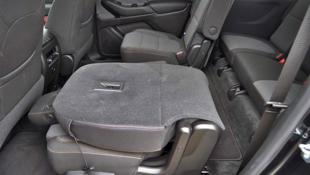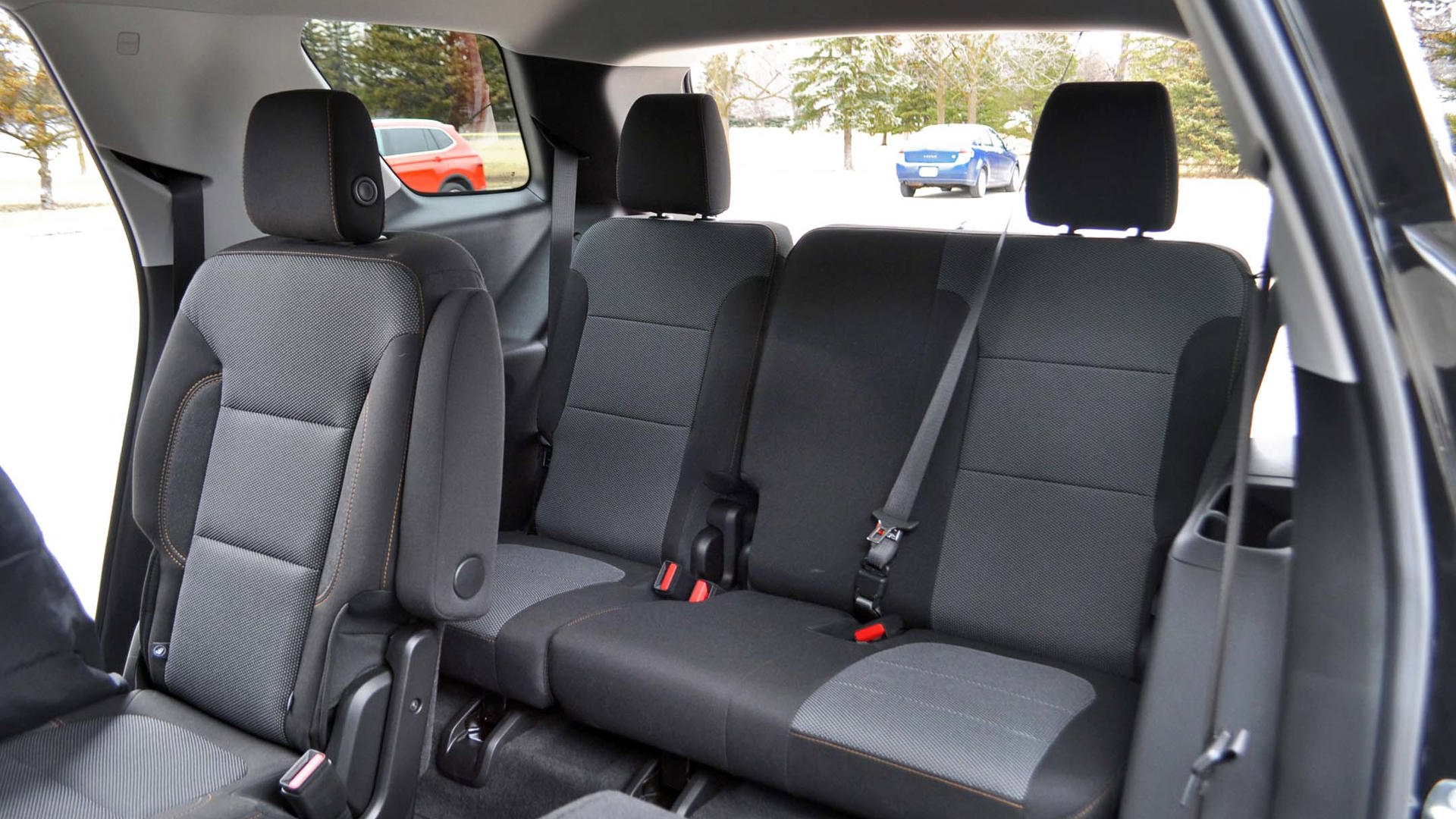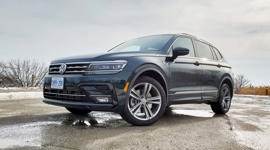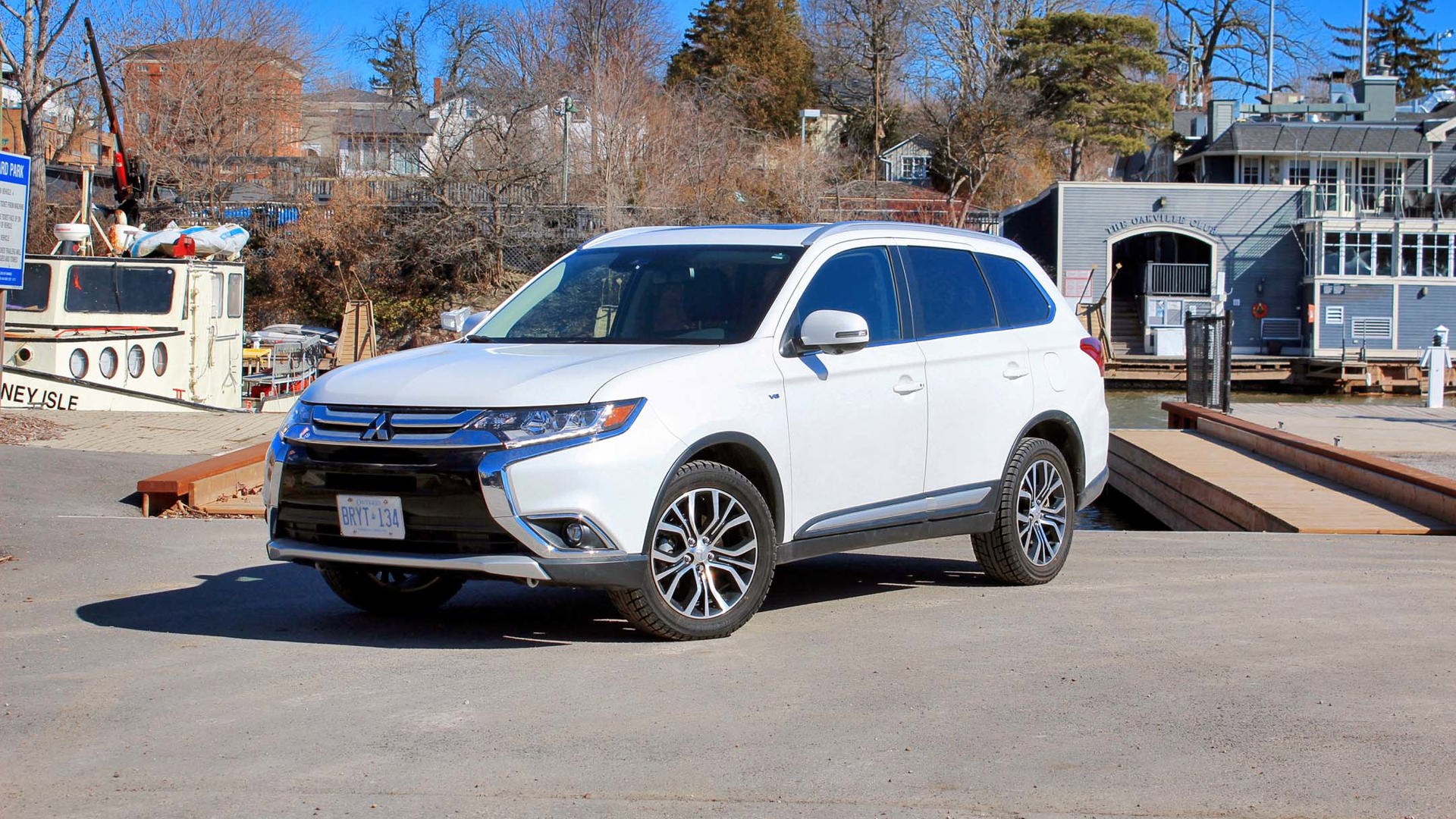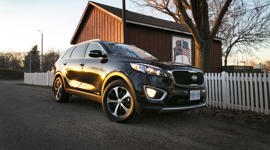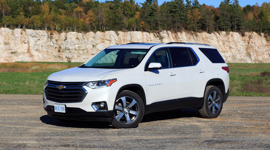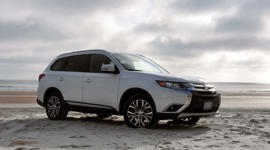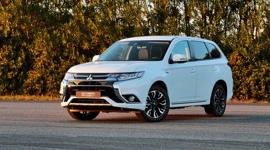Comparison Data
|
2018 Chevrolet Traverse LT AWD
|
2018 Kia Sorento EX V6
|
2018 Mitsubishi Outlander GT S-AWC
|
2018 Volkswagen Tiguan Highline
|
|---|---|---|---|
|
Engine Displacement
3.6L
|
3.3L
|
3.0L
|
2.0L
|
|
Engine Cylinders
V6
|
V6
|
V6
|
I4
|
|
Peak Horsepower
310 hp
|
290 hp
|
224 hp
|
184 hp
|
|
Peak Torque
266 lb-ft
|
252 lb-ft
|
215 lb-ft
|
221 lb-ft
|
|
Fuel Economy
13.7/9.4/11.8 L/100 km city/hwy/cmb
|
13.2/9.3/11.4 L/100 km city/hwy/cmb
|
12.0/8.8/10.6 L/100 km city/hwy/cmb
|
11.3/8.8/10.2 L/100 km city/hwy/cmb
|
|
Cargo Space
651 / 1,645 / 2,781 L
|
320 / 1,077 / 2,066 L
|
292 / 968 / 1,792 L
|
340 / 934 / 1,860 L
|
|
Base Price
$42,195
|
$37,495
|
$37,998
|
$39,175
|
|
A/C Tax
$100
|
$100
|
$100
|
$100
|
|
Destination Fee
$1,795
|
$1,740
|
$1,450
|
$1,845
|
|
Price as Tested
$44,585
|
$39,335
|
$39,748
|
$43,340
|
|
Optional Equipment
$495 – Mosaic Black Metallic Paint $495
|
None
|
$200 – Diamond White Paint $200
|
$2,220 – Driver Assistance Package $1,470; Third Row Package $750
|
Some buyers need three rows, while others could use a third row every once in a while. We began this comparison looking at it from both perspectives, hunting for the least expensive vehicles in Canada that offered three key features: a third row, four- or all-wheel drive, and SUV/crossover packaging.
Not that we have anything against minivans.
Not that we have anything against three-row minivans, even all-wheel-drive ones like the Toyota Sienna, or tiny three-row crossovers like the front-wheel-drive-only Kia Rondo. But the sales numbers in Canada make it fairly clear that buyers love their SUVs and crossovers, with a major part of that appeal being the AWD that usually comes with them.
We landed at roughly $40,000 as a good affordability target, where there were a few interesting three-row SUV options, with half of our four entrants sneaking over that line by a few thousand dollars, and a couple just under that target. Our assembled group consisted of the 2018 Chevrolet Traverse LT, Kia Sorento EX V6, the Mitsubishi Outlander GT, and the Volkswagen Tiguan Highline with the optional third row.
We should note a few vehicles that we tried to round up but either weren’t available, about to be replaced by an all-new model (and therefore unavailable from their respective makers); or were just too expensive as tested to be directly comparable – the Dodge Journey and Durango, Ford Flex and Explorer, Honda Pilot, Hyundai Santa Fe XL, Mazda CX-9, Nissan Rogue (which is phasing out the third-row option) and Pathfinder, and the Volkswagen Atlas (the Tiguan fit much better price-wise).
Of our assembled foursome, the Outlander and the Tiguan were basically fully loaded models, the Kia Sorento right around mid-level, while the notably larger Chevrolet was a lower mid-level trim for the AWD-equipped Traverse LT. How this factored into the final scoring, you’re about to find out.
Fourth Place: 2018 Mitsubishi Outlander GT S-AWC – Jacob Black
The 2018 Mitsubishi Outlander was sadly a distant last in this group. As the smallest vehicle in the field it was always going to have an uphill battle, and really the Outlander is probably just too small to shoehorn a third row into.
This comparison focused heavily on the third-row and cargo usability and practicality of these four cars, and the Outlander came up short. It’s good to have the option, but this third row is for emergencies only. The Outlander also felt dated, as Jil notes:
“The second-row seats fold, but you can only do this after you’ve flipped the cushions forward – an extra step. And it also limits how far back you can put the front seats when they’re flipped. In a world of one-touch, a two-part seat fold doesn’t really cut it anymore.”
Perhaps in an effort to save space, the third-row seats are thin and flimsy. “As good as the Outlander’s materials look in the first two rows, the third row is a cheap-feeling thing that looks like someone glued the seatbacks to pieces of Masonite,” explained Jil.
I had hoped the Outlander would peg back some ground with its 3.0L V6 – but that unit felt harsh and underpowered versus the Chevrolet Traverse and Kia Sorento. It was better than the Tiguan on paper at 224 hp and 215 lb-ft of torque, yet the Outlander never felt as convincing as any of these engines. Its combined fuel economy of 10.6 L/100 km is within a whisker of the smaller VW Tiguan and betters the two larger V6s by a decent margin, but much of that gain is eradicated by the fact it recommends premium fuel. Worse, it finished last on observed numbers. After a day of driving it was on 11.9 L/100 km versus 11.8 (Traverse), 11.6 (Sorento) and 10.8 (Tiguan).
I liked that the Outlander had paddle shifters attached to its six-speed automatic, though others found their prominent size a little over-the-top.
Ride quality wasn’t much better and with a numb on-centre steering, plus harsh, crashy suspension, the Outlander was our least comfortable on the road. Despite sporting Mitsubishi’s Super All-Wheel Control, the Outlander was prone to understeer and obstinance on turn-in. I expected more, especially given the short wheelbase. Jil did note that the Outlander’s brakes were the “best of the bunch”.
Peter thought the Outlander’s interior was deserving of praise, noting: “The dash looks good – nicely put together with a reasonably logical infotainment system and clear gauge cluster. The high seating position and thin pillars make for good outward visibility.”
And he’s right, this is a much better place to be than previous generations of the Outlander. But while the infotainment system does have Android Auto and Apple CarPlay, this system falls down when you compare it to the competition with its single volume knob and convoluted menus. It looks and feels dated.
The Outlander is an old dog, for sure, but as Michael notes, that doesn’t mean it is devoid of new tricks. “The Outlander still has some very useful features: a heated steering wheel, and a camera function that not only gives you the handy above view to check your painted-line parking prowess, but also a right-side view that’s extra helpful for parallel parking.”
That parking view and its diminutive size means the Outlander is the best of this bunch when it comes to parking – and for a young family in the downtown area, this might be the best option until they move out of underground parking hell.
Worth noting too: you get the full suite of electronic driving aids and safety features here at $39,748 as-tested, where the Traverse at $44,585 was in the middle of its trim climb. Not only that but the Outlander has a staunch 10-year warranty which will give unparalleled piece of mind in this segment.
As Peter says, “On its own, not a bad crossover.”
If you’re looking for high-level safety equipment and features for a low outlay this Outlander puts up a compelling case on paper. But driven back-to-back with the competition, its flaws are difficult to overlook.
Third Place: 2018 Kia Sorento EX V6 – Michael Bettencourt
When you you’re the quickest, best-looking (arguably), and least expensive in any comparison test, you have a good shot of winning – and so it is here. Throw in a healthy number of goodies inside, and the lowest as-tested price of the bunch, and you may think the Kia should have been a slam dunk for the top spot here. But it wasn’t, once the collective scores were in and tallied.
Okay, first the good, and there were lots of them: The Sorento was the Andre DeGrasse sprinter of the group, post-Usain Bolt’s retirement, with the best acceleration by far, and the most luxuriously energetic feeling of the bunch.
“The engine is a work of art, strong and smooth and quiet,” said Jil, in comments echoed throughout. “That V6 is a peach – smooth and strong,” said Peter, two key factors for many family-oriented buyers, especially if you’re considering towing anything with your seven-seat hauler.
As usual, there’s also a strong value proposition in the Kia here. The Sorento offers lots of features inside, but with this mid-level EX V6, it didn’t wow with features as much as higher trim Kias often achieve. Still, with the lowest price of the group, a very healthy list of convenience items, and plenty of room inside; it offered the most for the least, price-wise, though its value score still ended up second behind the fully loaded but pricier Tiguan.
“It was the cheapest of the bunch, but it didn’t feel like it,” opined Jil. “Kia’s mantra is to give you a lot of features for the money, and the Sorento doesn’t disappoint on that.”
The third row also came in for praise as accessible and habitable even if you’re not looking forward to your grade school graduation. “Kia has sacrificed cargo volume for third-row comfort, and actual grown adults will be very pleased with the ample leg- and headroom back there,” said Jacob.
In fact, it ended up ranked second a lot, and that was the Kia’s main issue. In design, seating comfort, and fuel economy, it came in second, with just a couple other scores pulling it down into third place overall. It didn’t out-and-out lose any of our ranked categories, speaking to its high capabilities in many areas; but at least at this price and trim level, it didn’t blow away the majority of our testers in any particular area either.
And then there were the niggles that brought its overall scores down. For example, it’s very likely that higher trims will offer better sound than the tinny ear tickles coming from the Kia’s six speakers. But it’s also true that there are likely lower-priced cars with better sound than the Sorento.
“The audio system’s a letdown,” said our resident musician and audiophile Peter Bleakney. “The other three here all had good systems.”
Then there were the brakes that provided only vague feedback of vehicle retardation when pressed, in contrast to the others here. “Can someone please return the Kia’s brake feel? It really misses it,” snarked one anonymous writer (okay, me), in an area commented upon by various testers. The ride was decent but strangely still with some impact harshness, noted others.
But really, this was a solid all-around performer, as Jacob noted.
“A classic case of ‘Yep, that’s a good decision,’ without any dramatics or excess.”
Second Place: 2018 Volkswagen Tiguan Highline – Peter Bleakney
Introduced here in 2007, the Volkswagen Tiguan crossover was a bit of a “tweener”. It was smaller than the RAV4/CR-V crowd, yet bigger than the subcompact set, and while its “GTI on stilts” driving demeanour appealed to those who care about such things, the little Tig was not a big seller in North America.
So for 2018, the all-new Tiguan trades most of its zippy personality for something altogether more important in this segment: space. And just to be sure, VW is only selling the long-wheelbase version with available third-row seating here in North America.
The 2018 Tiguan starts at $28,925 for the front-drive model, but our top-tier Highline 4Motion came out to $43,340 as tested. And of this group it was the most comprehensively equipped, bragging navigation, heated steering wheel, massive panoramic sunroof, leather, LED headlamps, Android Auto, Apple CarPlay, blind-spot detection, rear cross-traffic alert, and more.
The cheery orange paint shows off the Tig’s handsome shape and sharp detailing, and inside the VW story continues with the expected high-quality cabin. Everything looks crisp and lovingly rendered, highlighted by an intuitive 8-inch touchscreen interface and, in front of the driver, Volkswagen’s configurable Digital Cockpit instrument cluster that is not that far off of Audi’s impressive Virtual Cockpit. We all thought the standard 400-watt Fender audio sounded spectacular.
Jacob stated, “Colourful, fun and modern, the Tiguan packed the best infotainment system by a long margin, the nicest interior and the best looks.” The only minor cabin gripe was the combination driver seat heat/steering wheel heat switch.
The third row scored third in comfort within this group – access is a bit tricky and comfort so-so. But that said, these perches are certainly serviceable for both kids or smaller adults when the need arises, and that is the whole point here. No one is going to be travelling cross-country back here. Hopefully.
The second row is well equipped for family duty – it reclines, slides for and aft, has air vents and a USB port. There’s also a decent amount of storage behind the third row. Conversely, with both third and second rows folded, the 2018 Tiguan is a champion hauler.
What caught us off guard was the grittiness of its 2.0L turbocharged four-cylinder – an engine that in other VW/Audi applications has never failed to win love. Here it makes 184 horsepower and 221 lb-ft from 1,600 rpm, and its growl could come from a new Miller-cycle-ish combustion process introduced here to reduced fuel consumption. No complaints with the smooth eight-speed Tiptronic though. Once on the boil, the four-pot moves the Tig out smartly enough, although Jil noted, “I can’t imagine how it would be if you actually loaded all three rows.” As might be expected, the Tiguan soundly trounced the V6s when it came to fuel economy.
This new Tiguan might not be as sporty as the outgoing model, but it still goes down the road with the classic VW poise and body control. Yes, we could ask for more steering feel, but it was certainly direct and accurate. The ride is firmer than that of the Chevy and Sorento, but more on the sporty side, as opposed the Outlander which is just plain harsh on some surfaces.
The Tiguan scored best for value, which historically is something we’re not used to from Volkswagen, but here the hits just kept on coming: auto adaptive high-beams, memory seats, 360-degree view camera, and foot-swipe operation for the powered lift-gate. As Michael put it, “This is the tech-savvy urban Masters grad that turned out to be a remarkably capable all-rounder.”
Winner: 2018 Chevrolet Traverse LT AWD – Jil McIntosh
Our own Jacob Black is notoriously hard to please, and so when he dubbed the Traverse the “Sultan of Smooth”, we knew the stage was set. Chevrolet took this comparo’s top spot honestly, with a great ride, quiet and spacious cabin, and strong engine.
It was optioned to the priciest of all. But it was also the largest, which translated into far more interior space – and that’s an important consideration when you’re filling three rows in a family vehicle. That said, size matters in other ways as well, and the big Traverse also chewed up the most fuel.
Of the four tested, the Traverse and Sorento offered relatively easy access to the third row, and once you were back there, the Traverse easily wiped the floor with the other three, with enough room for people who actually have legs.
It certainly didn’t hurt that it was the only one with two second-row captain’s chairs, rather than a bench seat, but if you’re going to put three rows in, the third needs to have at least some semblance of accessibility. When Michael Bettencourt took one for the team and squeezed into the Mitsubishi’s back chairs, we thought we’d need a can opener to get him out – and he’s thin!
And if you have all the rows filled, what do you do with your passengers’ stuff? Once again, the Traverse led the way. The Chevy’s 651 L of cargo space with the third row up was 311 L more than the next-most-voluminous Tiguan, and more than double that of the Outlander, the smallest sport-ute tested here.
I thought the Mitsubishi had the best visibility of all, including a way-cool side view camera for checking curbs alongside, while the Tiguan got my vote for the easiest to back into a space. On the Traverse, Peter Bleakney noted that “the super-thick A-pillars impede visibility.” He’s right, but even so, the Traverse didn’t feel cumbersome. It’s only when you glance in the rear-view mirror that you realize how much real estate is behind you.
With its refined ride and well-controlled body motions, “it actually proved amongst the most dynamically adept, if far from entertaining,” according to Bettencourt, and I agree with him. Both the Tiguan and Outlander had far more engaging steering feel and response, but at the same time, this is a segment where people are taking the gang to the game, to the mall, on a long commute, and this is the kind of performance they expect.
The powertrain can be switched from front-wheel to all-wheel using a dial on the console. Like many vehicles today, the Traverse features auto stop-start, which shuts off the engine at idle to improve fuel economy and emissions (everything else continues to work, such as the lights, climate control, and stereo). What I don’t like is that on virtually every other vehicle with it, you can shut it off if you want the engine to stay running. The Traverse doesn’t give you that option. I want to control what my car does when I’m stopped, thank you very much.
The Traverse’s size accounted for some of its higher price, but at the same time, we expected more features, given what you got in the others for less money. I liked the Traverse’s heated cloth seats, but I’m in the minority on that. Everything else had heated leather chairs, and most buyers expect cowhide around the $40,000 mark.
All the competitors had a heated steering wheel too, a glaring omission on the Chevy. Yeah, I know, do I want it to make coffee for me too? Still, in a very short period, heated steering wheels have gone from an unheard-of luxury in a few ultra-premium cars, to gotta-have-it for many buyers in our climate. (Hey, air conditioning used to be only for uppity-ups, too.)
The Tiguan, with the next-highest price tag, was the only one of our testers with navigation. The Traverse has a Directions & Connections plan in its OnStar package, which sends a route to the infotainment system once you’ve hit the OnStar button and asked a real person for it. It works well, but you have to renew it once the trial period runs out. The Traverse also includes a Wi-Fi hotspot under the same subscription-style plan.
I honestly thought the Traverse would come up just shy of the top spot, due to its price tag and fuel consumption, but you can’t keep a good trucklet down. Despite its shortcomings, the Traverse’s quiet ride, interior space, comfortable seating, and strong engine teamed up to put it a nose ahead in front.
